Reflective Essay on Medication Management in Nursing
VerifiedAdded on 2022/10/15
|20
|5815
|168
AI Summary
This reflective essay focuses on medication management in nursing, discussing the routes of drug administration, the 5 rights of drug administration, and nurses' knowledge of how drugs work and their effects on the patient. It includes a concept map and SNOB analysis. Course code SHN286.
Contribute Materials
Your contribution can guide someone’s learning journey. Share your
documents today.
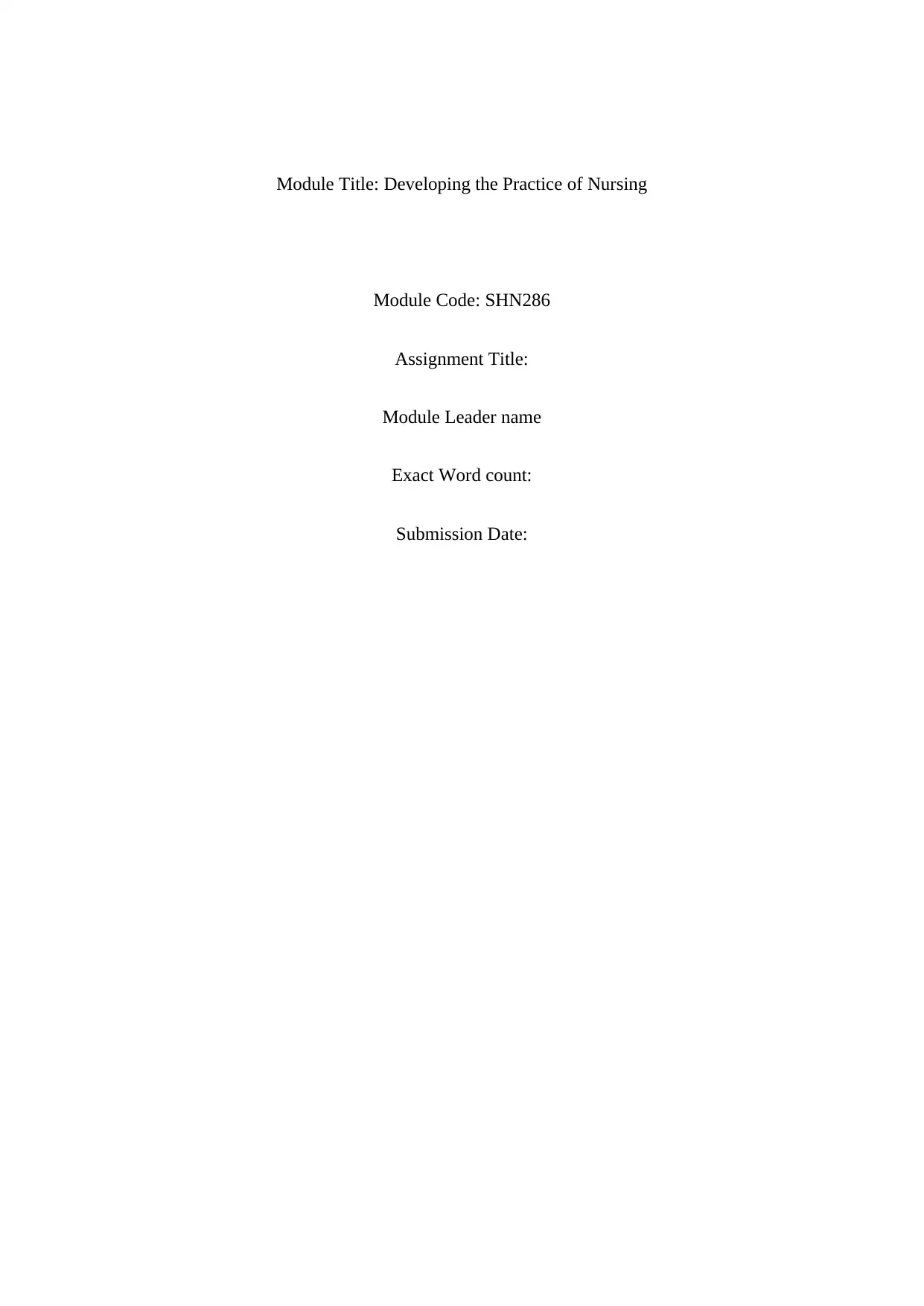
Module Title: Developing the Practice of Nursing
Module Code: SHN286
Assignment Title:
Module Leader name
Exact Word count:
Submission Date:
Module Code: SHN286
Assignment Title:
Module Leader name
Exact Word count:
Submission Date:
Secure Best Marks with AI Grader
Need help grading? Try our AI Grader for instant feedback on your assignments.
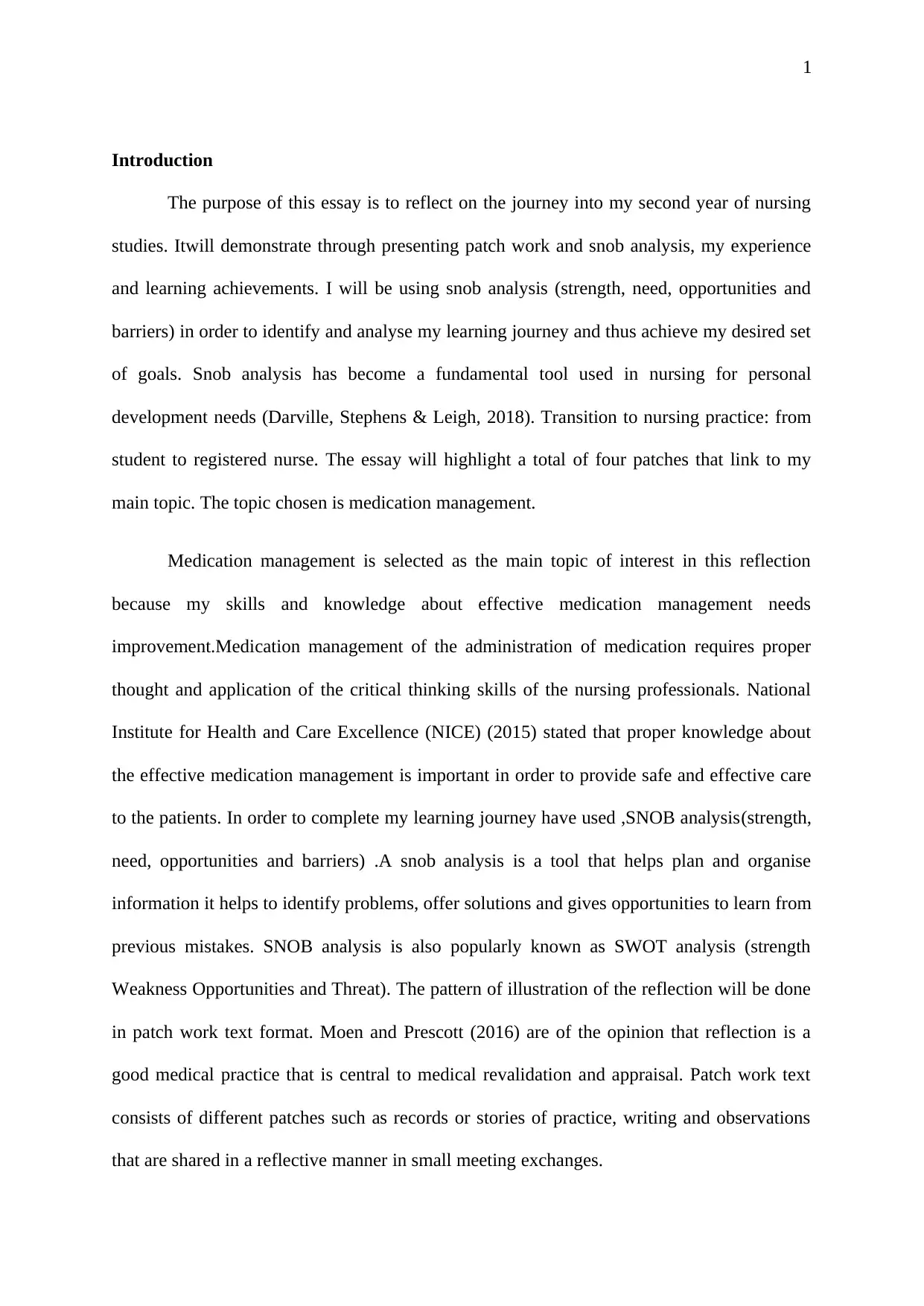
1
Introduction
The purpose of this essay is to reflect on the journey into my second year of nursing
studies. Itwill demonstrate through presenting patch work and snob analysis, my experience
and learning achievements. I will be using snob analysis (strength, need, opportunities and
barriers) in order to identify and analyse my learning journey and thus achieve my desired set
of goals. Snob analysis has become a fundamental tool used in nursing for personal
development needs (Darville, Stephens & Leigh, 2018). Transition to nursing practice: from
student to registered nurse. The essay will highlight a total of four patches that link to my
main topic. The topic chosen is medication management.
Medication management is selected as the main topic of interest in this reflection
because my skills and knowledge about effective medication management needs
improvement.Medication management of the administration of medication requires proper
thought and application of the critical thinking skills of the nursing professionals. National
Institute for Health and Care Excellence (NICE) (2015) stated that proper knowledge about
the effective medication management is important in order to provide safe and effective care
to the patients. In order to complete my learning journey have used ,SNOB analysis(strength,
need, opportunities and barriers) .A snob analysis is a tool that helps plan and organise
information it helps to identify problems, offer solutions and gives opportunities to learn from
previous mistakes. SNOB analysis is also popularly known as SWOT analysis (strength
Weakness Opportunities and Threat). The pattern of illustration of the reflection will be done
in patch work text format. Moen and Prescott (2016) are of the opinion that reflection is a
good medical practice that is central to medical revalidation and appraisal. Patch work text
consists of different patches such as records or stories of practice, writing and observations
that are shared in a reflective manner in small meeting exchanges.
Introduction
The purpose of this essay is to reflect on the journey into my second year of nursing
studies. Itwill demonstrate through presenting patch work and snob analysis, my experience
and learning achievements. I will be using snob analysis (strength, need, opportunities and
barriers) in order to identify and analyse my learning journey and thus achieve my desired set
of goals. Snob analysis has become a fundamental tool used in nursing for personal
development needs (Darville, Stephens & Leigh, 2018). Transition to nursing practice: from
student to registered nurse. The essay will highlight a total of four patches that link to my
main topic. The topic chosen is medication management.
Medication management is selected as the main topic of interest in this reflection
because my skills and knowledge about effective medication management needs
improvement.Medication management of the administration of medication requires proper
thought and application of the critical thinking skills of the nursing professionals. National
Institute for Health and Care Excellence (NICE) (2015) stated that proper knowledge about
the effective medication management is important in order to provide safe and effective care
to the patients. In order to complete my learning journey have used ,SNOB analysis(strength,
need, opportunities and barriers) .A snob analysis is a tool that helps plan and organise
information it helps to identify problems, offer solutions and gives opportunities to learn from
previous mistakes. SNOB analysis is also popularly known as SWOT analysis (strength
Weakness Opportunities and Threat). The pattern of illustration of the reflection will be done
in patch work text format. Moen and Prescott (2016) are of the opinion that reflection is a
good medical practice that is central to medical revalidation and appraisal. Patch work text
consists of different patches such as records or stories of practice, writing and observations
that are shared in a reflective manner in small meeting exchanges.
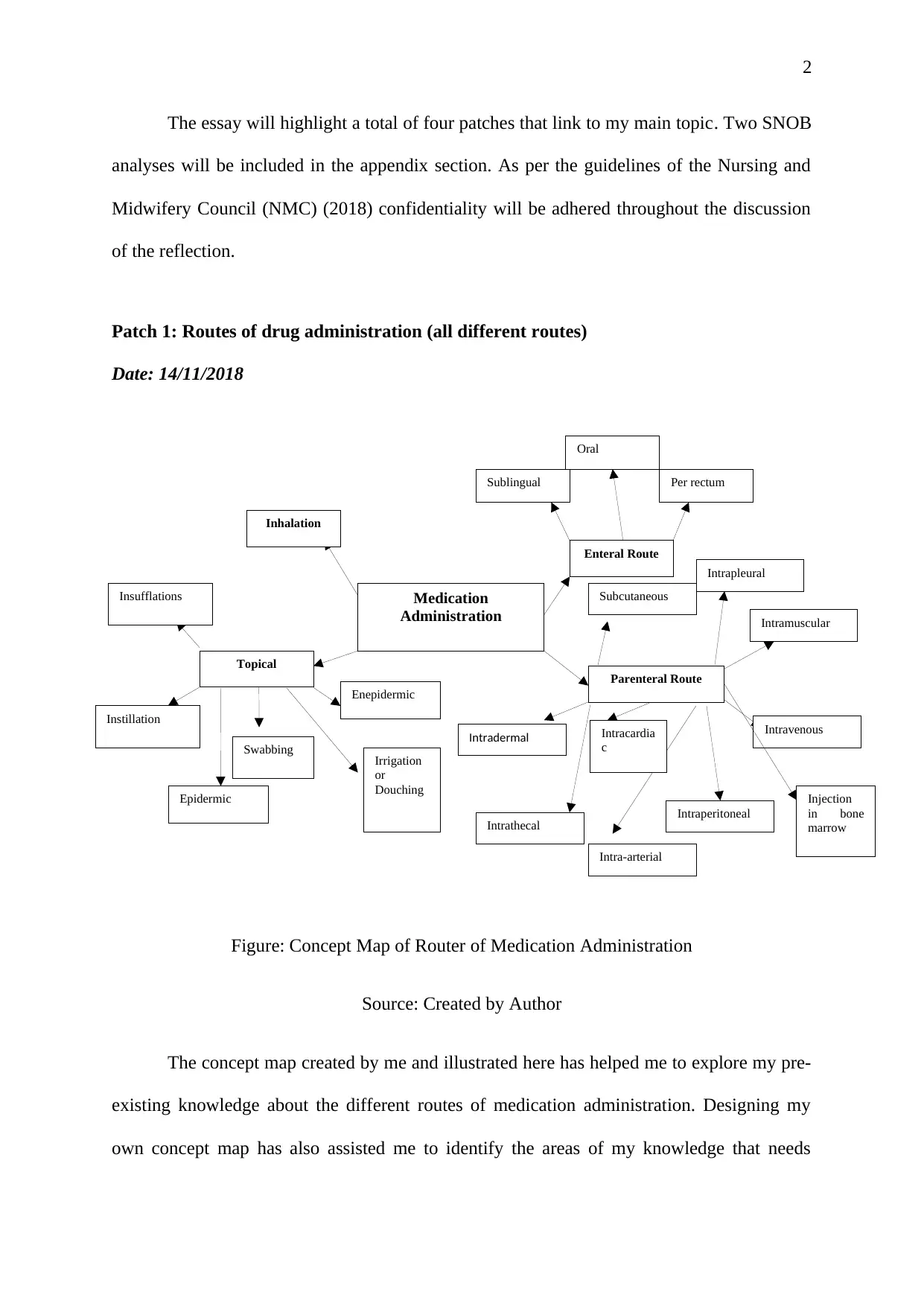
Medication
Administration
Enteral Route
Parenteral Route
Topical
Inhalation
Enepidermic
Swabbing
Instillation
Insufflations
Irrigation
or
Douching
Epidermic
Sublingual Per rectum
Oral
Subcutaneous
Intrapleural
Intramuscular
Intravenous
Intraperitoneal
Intra-arterial
Intrathecal
Intradermal Intracardia
c
Injection
in bone
marrow
2
The essay will highlight a total of four patches that link to my main topic. Two SNOB
analyses will be included in the appendix section. As per the guidelines of the Nursing and
Midwifery Council (NMC) (2018) confidentiality will be adhered throughout the discussion
of the reflection.
Patch 1: Routes of drug administration (all different routes)
Date: 14/11/2018
Figure: Concept Map of Router of Medication Administration
Source: Created by Author
The concept map created by me and illustrated here has helped me to explore my pre-
existing knowledge about the different routes of medication administration. Designing my
own concept map has also assisted me to identify the areas of my knowledge that needs
Administration
Enteral Route
Parenteral Route
Topical
Inhalation
Enepidermic
Swabbing
Instillation
Insufflations
Irrigation
or
Douching
Epidermic
Sublingual Per rectum
Oral
Subcutaneous
Intrapleural
Intramuscular
Intravenous
Intraperitoneal
Intra-arterial
Intrathecal
Intradermal Intracardia
c
Injection
in bone
marrow
2
The essay will highlight a total of four patches that link to my main topic. Two SNOB
analyses will be included in the appendix section. As per the guidelines of the Nursing and
Midwifery Council (NMC) (2018) confidentiality will be adhered throughout the discussion
of the reflection.
Patch 1: Routes of drug administration (all different routes)
Date: 14/11/2018
Figure: Concept Map of Router of Medication Administration
Source: Created by Author
The concept map created by me and illustrated here has helped me to explore my pre-
existing knowledge about the different routes of medication administration. Designing my
own concept map has also assisted me to identify the areas of my knowledge that needs
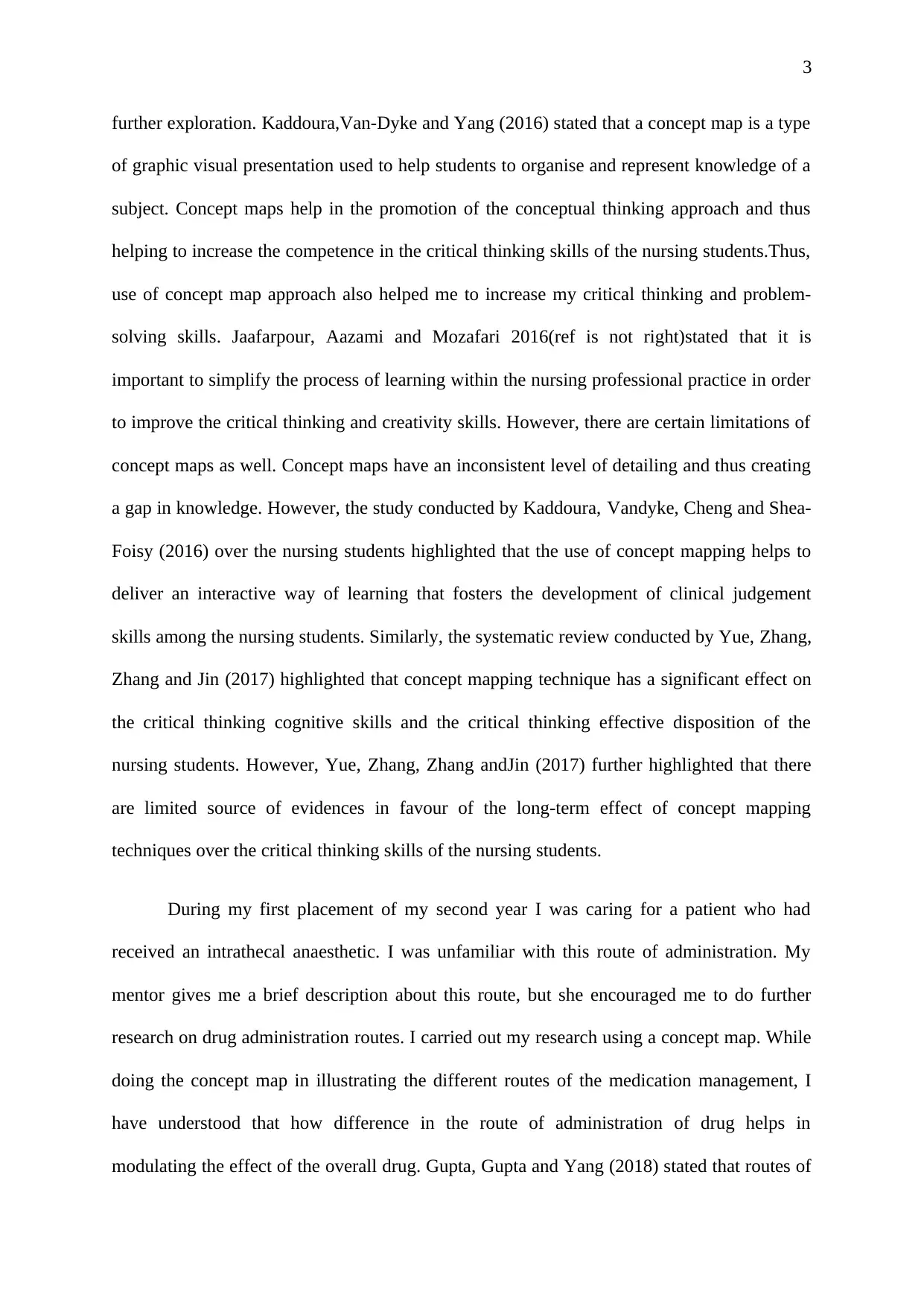
3
further exploration. Kaddoura,Van‐Dyke and Yang (2016) stated that a concept map is a type
of graphic visual presentation used to help students to organise and represent knowledge of a
subject. Concept maps help in the promotion of the conceptual thinking approach and thus
helping to increase the competence in the critical thinking skills of the nursing students.Thus,
use of concept map approach also helped me to increase my critical thinking and problem-
solving skills. Jaafarpour, Aazami and Mozafari 2016(ref is not right)stated that it is
important to simplify the process of learning within the nursing professional practice in order
to improve the critical thinking and creativity skills. However, there are certain limitations of
concept maps as well. Concept maps have an inconsistent level of detailing and thus creating
a gap in knowledge. However, the study conducted by Kaddoura, Vandyke, Cheng and Shea-
Foisy (2016) over the nursing students highlighted that the use of concept mapping helps to
deliver an interactive way of learning that fosters the development of clinical judgement
skills among the nursing students. Similarly, the systematic review conducted by Yue, Zhang,
Zhang and Jin (2017) highlighted that concept mapping technique has a significant effect on
the critical thinking cognitive skills and the critical thinking effective disposition of the
nursing students. However, Yue, Zhang, Zhang andJin (2017) further highlighted that there
are limited source of evidences in favour of the long-term effect of concept mapping
techniques over the critical thinking skills of the nursing students.
During my first placement of my second year I was caring for a patient who had
received an intrathecal anaesthetic. I was unfamiliar with this route of administration. My
mentor gives me a brief description about this route, but she encouraged me to do further
research on drug administration routes. I carried out my research using a concept map. While
doing the concept map in illustrating the different routes of the medication management, I
have understood that how difference in the route of administration of drug helps in
modulating the effect of the overall drug. Gupta, Gupta and Yang (2018) stated that routes of
further exploration. Kaddoura,Van‐Dyke and Yang (2016) stated that a concept map is a type
of graphic visual presentation used to help students to organise and represent knowledge of a
subject. Concept maps help in the promotion of the conceptual thinking approach and thus
helping to increase the competence in the critical thinking skills of the nursing students.Thus,
use of concept map approach also helped me to increase my critical thinking and problem-
solving skills. Jaafarpour, Aazami and Mozafari 2016(ref is not right)stated that it is
important to simplify the process of learning within the nursing professional practice in order
to improve the critical thinking and creativity skills. However, there are certain limitations of
concept maps as well. Concept maps have an inconsistent level of detailing and thus creating
a gap in knowledge. However, the study conducted by Kaddoura, Vandyke, Cheng and Shea-
Foisy (2016) over the nursing students highlighted that the use of concept mapping helps to
deliver an interactive way of learning that fosters the development of clinical judgement
skills among the nursing students. Similarly, the systematic review conducted by Yue, Zhang,
Zhang and Jin (2017) highlighted that concept mapping technique has a significant effect on
the critical thinking cognitive skills and the critical thinking effective disposition of the
nursing students. However, Yue, Zhang, Zhang andJin (2017) further highlighted that there
are limited source of evidences in favour of the long-term effect of concept mapping
techniques over the critical thinking skills of the nursing students.
During my first placement of my second year I was caring for a patient who had
received an intrathecal anaesthetic. I was unfamiliar with this route of administration. My
mentor gives me a brief description about this route, but she encouraged me to do further
research on drug administration routes. I carried out my research using a concept map. While
doing the concept map in illustrating the different routes of the medication management, I
have understood that how difference in the route of administration of drug helps in
modulating the effect of the overall drug. Gupta, Gupta and Yang (2018) stated that routes of
Secure Best Marks with AI Grader
Need help grading? Try our AI Grader for instant feedback on your assignments.
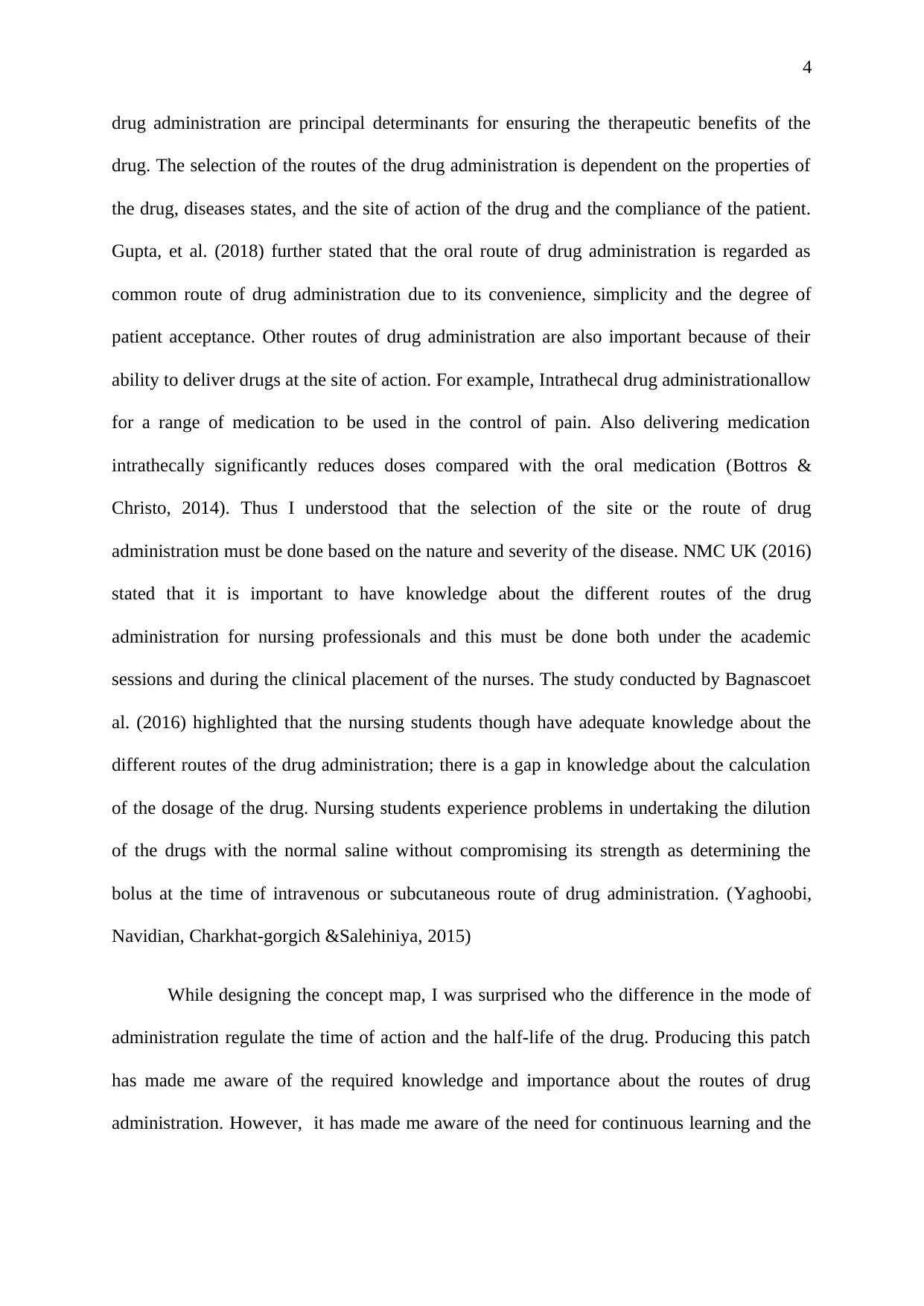
4
drug administration are principal determinants for ensuring the therapeutic benefits of the
drug. The selection of the routes of the drug administration is dependent on the properties of
the drug, diseases states, and the site of action of the drug and the compliance of the patient.
Gupta, et al. (2018) further stated that the oral route of drug administration is regarded as
common route of drug administration due to its convenience, simplicity and the degree of
patient acceptance. Other routes of drug administration are also important because of their
ability to deliver drugs at the site of action. For example, Intrathecal drug administrationallow
for a range of medication to be used in the control of pain. Also delivering medication
intrathecally significantly reduces doses compared with the oral medication (Bottros &
Christo, 2014). Thus I understood that the selection of the site or the route of drug
administration must be done based on the nature and severity of the disease. NMC UK (2016)
stated that it is important to have knowledge about the different routes of the drug
administration for nursing professionals and this must be done both under the academic
sessions and during the clinical placement of the nurses. The study conducted by Bagnascoet
al. (2016) highlighted that the nursing students though have adequate knowledge about the
different routes of the drug administration; there is a gap in knowledge about the calculation
of the dosage of the drug. Nursing students experience problems in undertaking the dilution
of the drugs with the normal saline without compromising its strength as determining the
bolus at the time of intravenous or subcutaneous route of drug administration. (Yaghoobi,
Navidian, Charkhat-gorgich &Salehiniya, 2015)
While designing the concept map, I was surprised who the difference in the mode of
administration regulate the time of action and the half-life of the drug. Producing this patch
has made me aware of the required knowledge and importance about the routes of drug
administration. However, it has made me aware of the need for continuous learning and the
drug administration are principal determinants for ensuring the therapeutic benefits of the
drug. The selection of the routes of the drug administration is dependent on the properties of
the drug, diseases states, and the site of action of the drug and the compliance of the patient.
Gupta, et al. (2018) further stated that the oral route of drug administration is regarded as
common route of drug administration due to its convenience, simplicity and the degree of
patient acceptance. Other routes of drug administration are also important because of their
ability to deliver drugs at the site of action. For example, Intrathecal drug administrationallow
for a range of medication to be used in the control of pain. Also delivering medication
intrathecally significantly reduces doses compared with the oral medication (Bottros &
Christo, 2014). Thus I understood that the selection of the site or the route of drug
administration must be done based on the nature and severity of the disease. NMC UK (2016)
stated that it is important to have knowledge about the different routes of the drug
administration for nursing professionals and this must be done both under the academic
sessions and during the clinical placement of the nurses. The study conducted by Bagnascoet
al. (2016) highlighted that the nursing students though have adequate knowledge about the
different routes of the drug administration; there is a gap in knowledge about the calculation
of the dosage of the drug. Nursing students experience problems in undertaking the dilution
of the drugs with the normal saline without compromising its strength as determining the
bolus at the time of intravenous or subcutaneous route of drug administration. (Yaghoobi,
Navidian, Charkhat-gorgich &Salehiniya, 2015)
While designing the concept map, I was surprised who the difference in the mode of
administration regulate the time of action and the half-life of the drug. Producing this patch
has made me aware of the required knowledge and importance about the routes of drug
administration. However, it has made me aware of the need for continuous learning and the
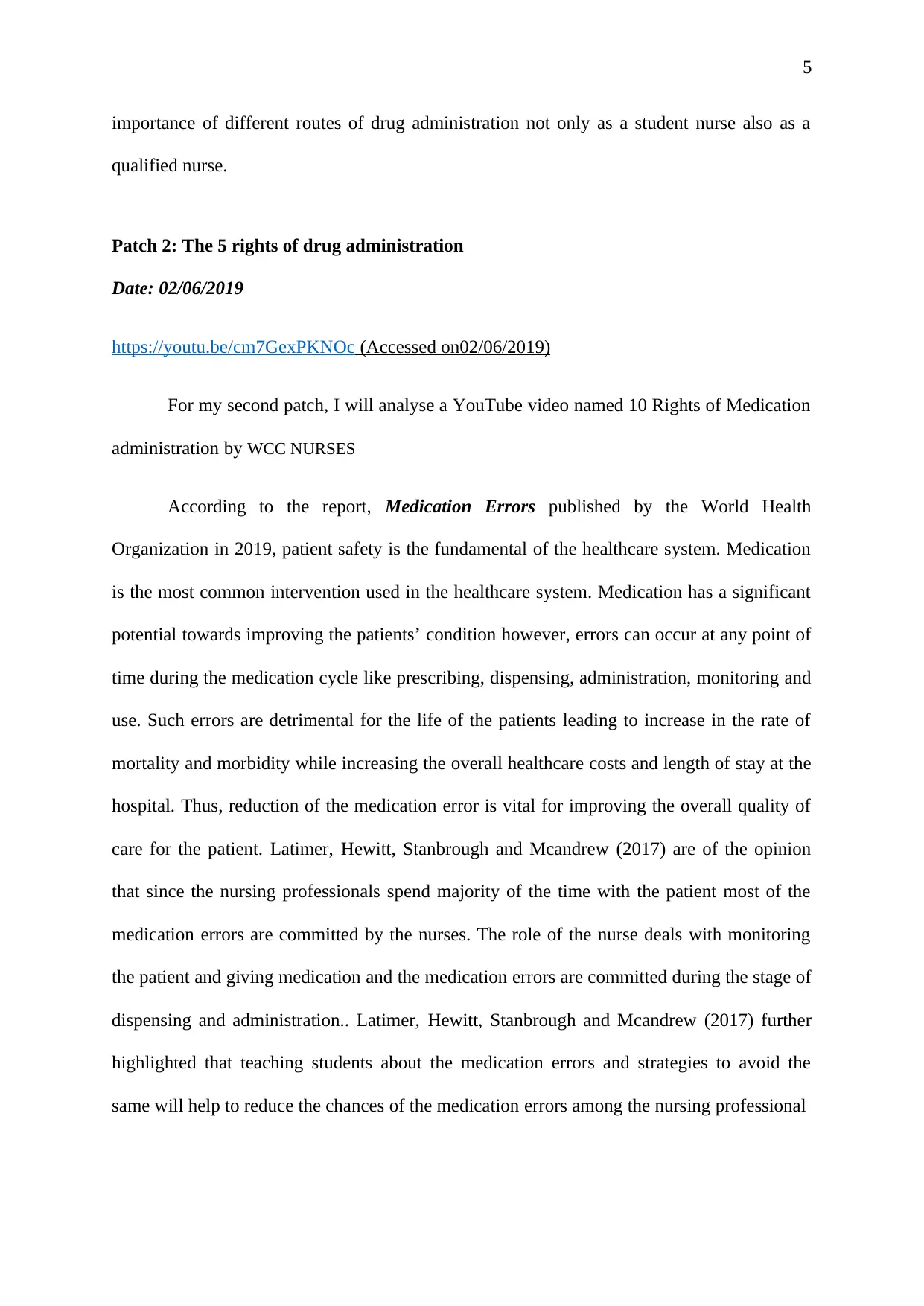
5
importance of different routes of drug administration not only as a student nurse also as a
qualified nurse.
Patch 2: The 5 rights of drug administration
Date: 02/06/2019
https://youtu.be/cm7GexPKNOc (Accessed on02/06/2019)
For my second patch, I will analyse a YouTube video named 10 Rights of Medication
administration by WCC NURSES
According to the report, Medication Errors published by the World Health
Organization in 2019, patient safety is the fundamental of the healthcare system. Medication
is the most common intervention used in the healthcare system. Medication has a significant
potential towards improving the patients’ condition however, errors can occur at any point of
time during the medication cycle like prescribing, dispensing, administration, monitoring and
use. Such errors are detrimental for the life of the patients leading to increase in the rate of
mortality and morbidity while increasing the overall healthcare costs and length of stay at the
hospital. Thus, reduction of the medication error is vital for improving the overall quality of
care for the patient. Latimer, Hewitt, Stanbrough and Mcandrew (2017) are of the opinion
that since the nursing professionals spend majority of the time with the patient most of the
medication errors are committed by the nurses. The role of the nurse deals with monitoring
the patient and giving medication and the medication errors are committed during the stage of
dispensing and administration.. Latimer, Hewitt, Stanbrough and Mcandrew (2017) further
highlighted that teaching students about the medication errors and strategies to avoid the
same will help to reduce the chances of the medication errors among the nursing professional
importance of different routes of drug administration not only as a student nurse also as a
qualified nurse.
Patch 2: The 5 rights of drug administration
Date: 02/06/2019
https://youtu.be/cm7GexPKNOc (Accessed on02/06/2019)
For my second patch, I will analyse a YouTube video named 10 Rights of Medication
administration by WCC NURSES
According to the report, Medication Errors published by the World Health
Organization in 2019, patient safety is the fundamental of the healthcare system. Medication
is the most common intervention used in the healthcare system. Medication has a significant
potential towards improving the patients’ condition however, errors can occur at any point of
time during the medication cycle like prescribing, dispensing, administration, monitoring and
use. Such errors are detrimental for the life of the patients leading to increase in the rate of
mortality and morbidity while increasing the overall healthcare costs and length of stay at the
hospital. Thus, reduction of the medication error is vital for improving the overall quality of
care for the patient. Latimer, Hewitt, Stanbrough and Mcandrew (2017) are of the opinion
that since the nursing professionals spend majority of the time with the patient most of the
medication errors are committed by the nurses. The role of the nurse deals with monitoring
the patient and giving medication and the medication errors are committed during the stage of
dispensing and administration.. Latimer, Hewitt, Stanbrough and Mcandrew (2017) further
highlighted that teaching students about the medication errors and strategies to avoid the
same will help to reduce the chances of the medication errors among the nursing professional
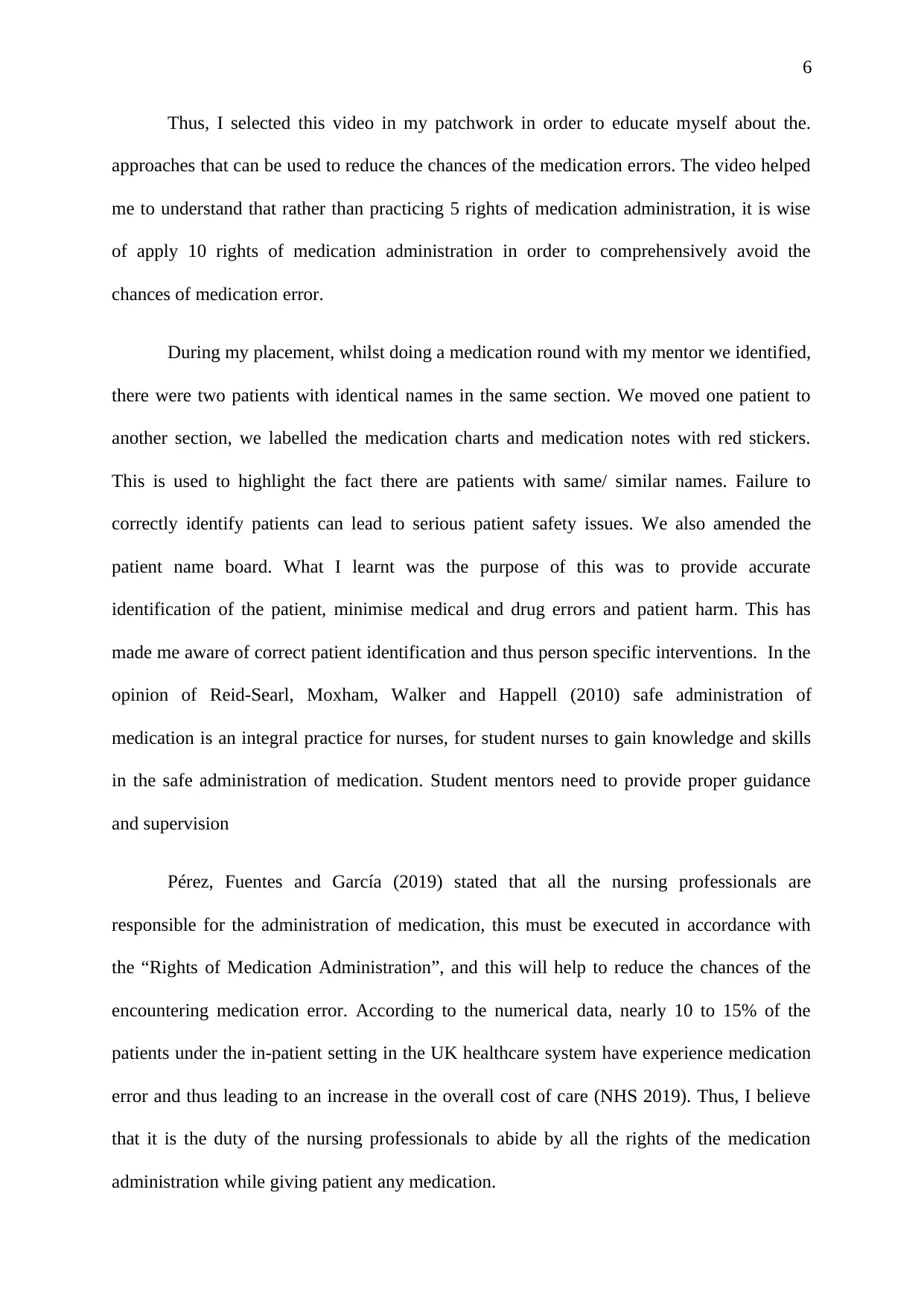
6
Thus, I selected this video in my patchwork in order to educate myself about the.
approaches that can be used to reduce the chances of the medication errors. The video helped
me to understand that rather than practicing 5 rights of medication administration, it is wise
of apply 10 rights of medication administration in order to comprehensively avoid the
chances of medication error.
During my placement, whilst doing a medication round with my mentor we identified,
there were two patients with identical names in the same section. We moved one patient to
another section, we labelled the medication charts and medication notes with red stickers.
This is used to highlight the fact there are patients with same/ similar names. Failure to
correctly identify patients can lead to serious patient safety issues. We also amended the
patient name board. What I learnt was the purpose of this was to provide accurate
identification of the patient, minimise medical and drug errors and patient harm. This has
made me aware of correct patient identification and thus person specific interventions. In the
opinion of Reid‐Searl, Moxham, Walker and Happell (2010) safe administration of
medication is an integral practice for nurses, for student nurses to gain knowledge and skills
in the safe administration of medication. Student mentors need to provide proper guidance
and supervision
Pérez, Fuentes and García (2019) stated that all the nursing professionals are
responsible for the administration of medication, this must be executed in accordance with
the “Rights of Medication Administration”, and this will help to reduce the chances of the
encountering medication error. According to the numerical data, nearly 10 to 15% of the
patients under the in-patient setting in the UK healthcare system have experience medication
error and thus leading to an increase in the overall cost of care (NHS 2019). Thus, I believe
that it is the duty of the nursing professionals to abide by all the rights of the medication
administration while giving patient any medication.
Thus, I selected this video in my patchwork in order to educate myself about the.
approaches that can be used to reduce the chances of the medication errors. The video helped
me to understand that rather than practicing 5 rights of medication administration, it is wise
of apply 10 rights of medication administration in order to comprehensively avoid the
chances of medication error.
During my placement, whilst doing a medication round with my mentor we identified,
there were two patients with identical names in the same section. We moved one patient to
another section, we labelled the medication charts and medication notes with red stickers.
This is used to highlight the fact there are patients with same/ similar names. Failure to
correctly identify patients can lead to serious patient safety issues. We also amended the
patient name board. What I learnt was the purpose of this was to provide accurate
identification of the patient, minimise medical and drug errors and patient harm. This has
made me aware of correct patient identification and thus person specific interventions. In the
opinion of Reid‐Searl, Moxham, Walker and Happell (2010) safe administration of
medication is an integral practice for nurses, for student nurses to gain knowledge and skills
in the safe administration of medication. Student mentors need to provide proper guidance
and supervision
Pérez, Fuentes and García (2019) stated that all the nursing professionals are
responsible for the administration of medication, this must be executed in accordance with
the “Rights of Medication Administration”, and this will help to reduce the chances of the
encountering medication error. According to the numerical data, nearly 10 to 15% of the
patients under the in-patient setting in the UK healthcare system have experience medication
error and thus leading to an increase in the overall cost of care (NHS 2019). Thus, I believe
that it is the duty of the nursing professionals to abide by all the rights of the medication
administration while giving patient any medication.
Paraphrase This Document
Need a fresh take? Get an instant paraphrase of this document with our AI Paraphraser
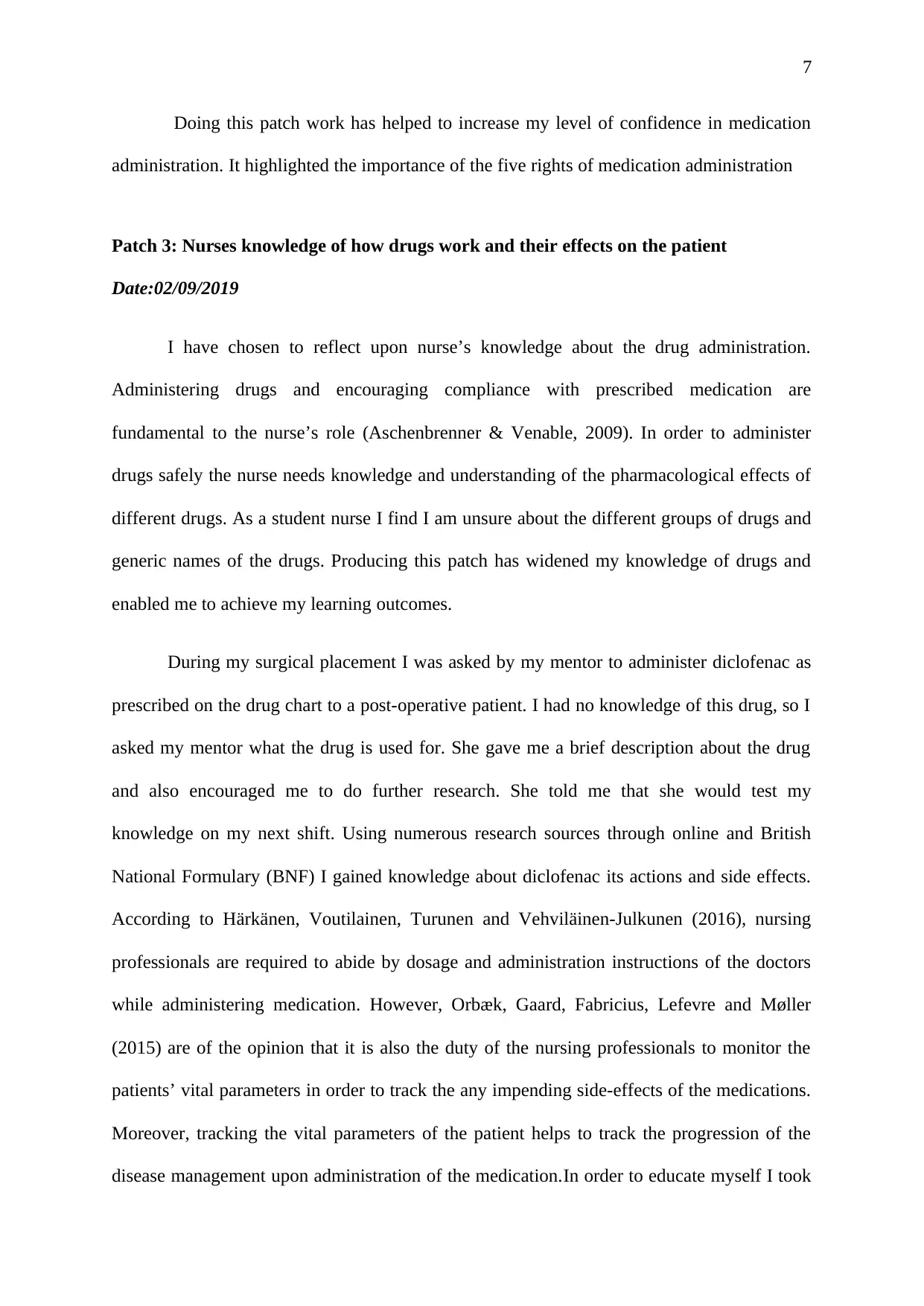
7
Doing this patch work has helped to increase my level of confidence in medication
administration. It highlighted the importance of the five rights of medication administration
Patch 3: Nurses knowledge of how drugs work and their effects on the patient
Date:02/09/2019
I have chosen to reflect upon nurse’s knowledge about the drug administration.
Administering drugs and encouraging compliance with prescribed medication are
fundamental to the nurse’s role (Aschenbrenner & Venable, 2009). In order to administer
drugs safely the nurse needs knowledge and understanding of the pharmacological effects of
different drugs. As a student nurse I find I am unsure about the different groups of drugs and
generic names of the drugs. Producing this patch has widened my knowledge of drugs and
enabled me to achieve my learning outcomes.
During my surgical placement I was asked by my mentor to administer diclofenac as
prescribed on the drug chart to a post-operative patient. I had no knowledge of this drug, so I
asked my mentor what the drug is used for. She gave me a brief description about the drug
and also encouraged me to do further research. She told me that she would test my
knowledge on my next shift. Using numerous research sources through online and British
National Formulary (BNF) I gained knowledge about diclofenac its actions and side effects.
According to Härkänen, Voutilainen, Turunen and Vehviläinen-Julkunen (2016), nursing
professionals are required to abide by dosage and administration instructions of the doctors
while administering medication. However, Orbæk, Gaard, Fabricius, Lefevre and Møller
(2015) are of the opinion that it is also the duty of the nursing professionals to monitor the
patients’ vital parameters in order to track the any impending side-effects of the medications.
Moreover, tracking the vital parameters of the patient helps to track the progression of the
disease management upon administration of the medication.In order to educate myself I took
Doing this patch work has helped to increase my level of confidence in medication
administration. It highlighted the importance of the five rights of medication administration
Patch 3: Nurses knowledge of how drugs work and their effects on the patient
Date:02/09/2019
I have chosen to reflect upon nurse’s knowledge about the drug administration.
Administering drugs and encouraging compliance with prescribed medication are
fundamental to the nurse’s role (Aschenbrenner & Venable, 2009). In order to administer
drugs safely the nurse needs knowledge and understanding of the pharmacological effects of
different drugs. As a student nurse I find I am unsure about the different groups of drugs and
generic names of the drugs. Producing this patch has widened my knowledge of drugs and
enabled me to achieve my learning outcomes.
During my surgical placement I was asked by my mentor to administer diclofenac as
prescribed on the drug chart to a post-operative patient. I had no knowledge of this drug, so I
asked my mentor what the drug is used for. She gave me a brief description about the drug
and also encouraged me to do further research. She told me that she would test my
knowledge on my next shift. Using numerous research sources through online and British
National Formulary (BNF) I gained knowledge about diclofenac its actions and side effects.
According to Härkänen, Voutilainen, Turunen and Vehviläinen-Julkunen (2016), nursing
professionals are required to abide by dosage and administration instructions of the doctors
while administering medication. However, Orbæk, Gaard, Fabricius, Lefevre and Møller
(2015) are of the opinion that it is also the duty of the nursing professionals to monitor the
patients’ vital parameters in order to track the any impending side-effects of the medications.
Moreover, tracking the vital parameters of the patient helps to track the progression of the
disease management upon administration of the medication.In order to educate myself I took
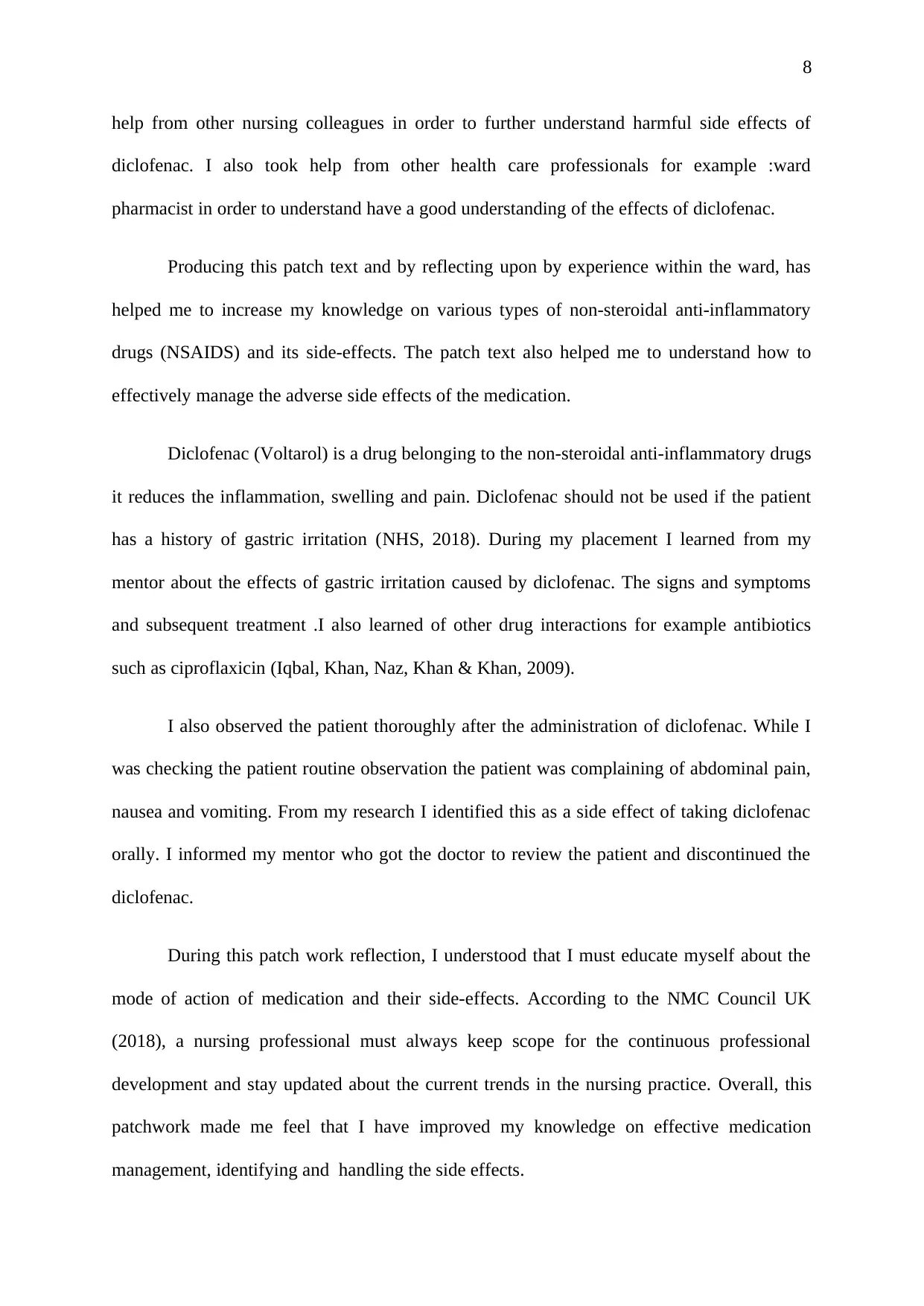
8
help from other nursing colleagues in order to further understand harmful side effects of
diclofenac. I also took help from other health care professionals for example :ward
pharmacist in order to understand have a good understanding of the effects of diclofenac.
Producing this patch text and by reflecting upon by experience within the ward, has
helped me to increase my knowledge on various types of non-steroidal anti-inflammatory
drugs (NSAIDS) and its side-effects. The patch text also helped me to understand how to
effectively manage the adverse side effects of the medication.
Diclofenac (Voltarol) is a drug belonging to the non-steroidal anti-inflammatory drugs
it reduces the inflammation, swelling and pain. Diclofenac should not be used if the patient
has a history of gastric irritation (NHS, 2018). During my placement I learned from my
mentor about the effects of gastric irritation caused by diclofenac. The signs and symptoms
and subsequent treatment .I also learned of other drug interactions for example antibiotics
such as ciproflaxicin (Iqbal, Khan, Naz, Khan & Khan, 2009).
I also observed the patient thoroughly after the administration of diclofenac. While I
was checking the patient routine observation the patient was complaining of abdominal pain,
nausea and vomiting. From my research I identified this as a side effect of taking diclofenac
orally. I informed my mentor who got the doctor to review the patient and discontinued the
diclofenac.
During this patch work reflection, I understood that I must educate myself about the
mode of action of medication and their side-effects. According to the NMC Council UK
(2018), a nursing professional must always keep scope for the continuous professional
development and stay updated about the current trends in the nursing practice. Overall, this
patchwork made me feel that I have improved my knowledge on effective medication
management, identifying and handling the side effects.
help from other nursing colleagues in order to further understand harmful side effects of
diclofenac. I also took help from other health care professionals for example :ward
pharmacist in order to understand have a good understanding of the effects of diclofenac.
Producing this patch text and by reflecting upon by experience within the ward, has
helped me to increase my knowledge on various types of non-steroidal anti-inflammatory
drugs (NSAIDS) and its side-effects. The patch text also helped me to understand how to
effectively manage the adverse side effects of the medication.
Diclofenac (Voltarol) is a drug belonging to the non-steroidal anti-inflammatory drugs
it reduces the inflammation, swelling and pain. Diclofenac should not be used if the patient
has a history of gastric irritation (NHS, 2018). During my placement I learned from my
mentor about the effects of gastric irritation caused by diclofenac. The signs and symptoms
and subsequent treatment .I also learned of other drug interactions for example antibiotics
such as ciproflaxicin (Iqbal, Khan, Naz, Khan & Khan, 2009).
I also observed the patient thoroughly after the administration of diclofenac. While I
was checking the patient routine observation the patient was complaining of abdominal pain,
nausea and vomiting. From my research I identified this as a side effect of taking diclofenac
orally. I informed my mentor who got the doctor to review the patient and discontinued the
diclofenac.
During this patch work reflection, I understood that I must educate myself about the
mode of action of medication and their side-effects. According to the NMC Council UK
(2018), a nursing professional must always keep scope for the continuous professional
development and stay updated about the current trends in the nursing practice. Overall, this
patchwork made me feel that I have improved my knowledge on effective medication
management, identifying and handling the side effects.
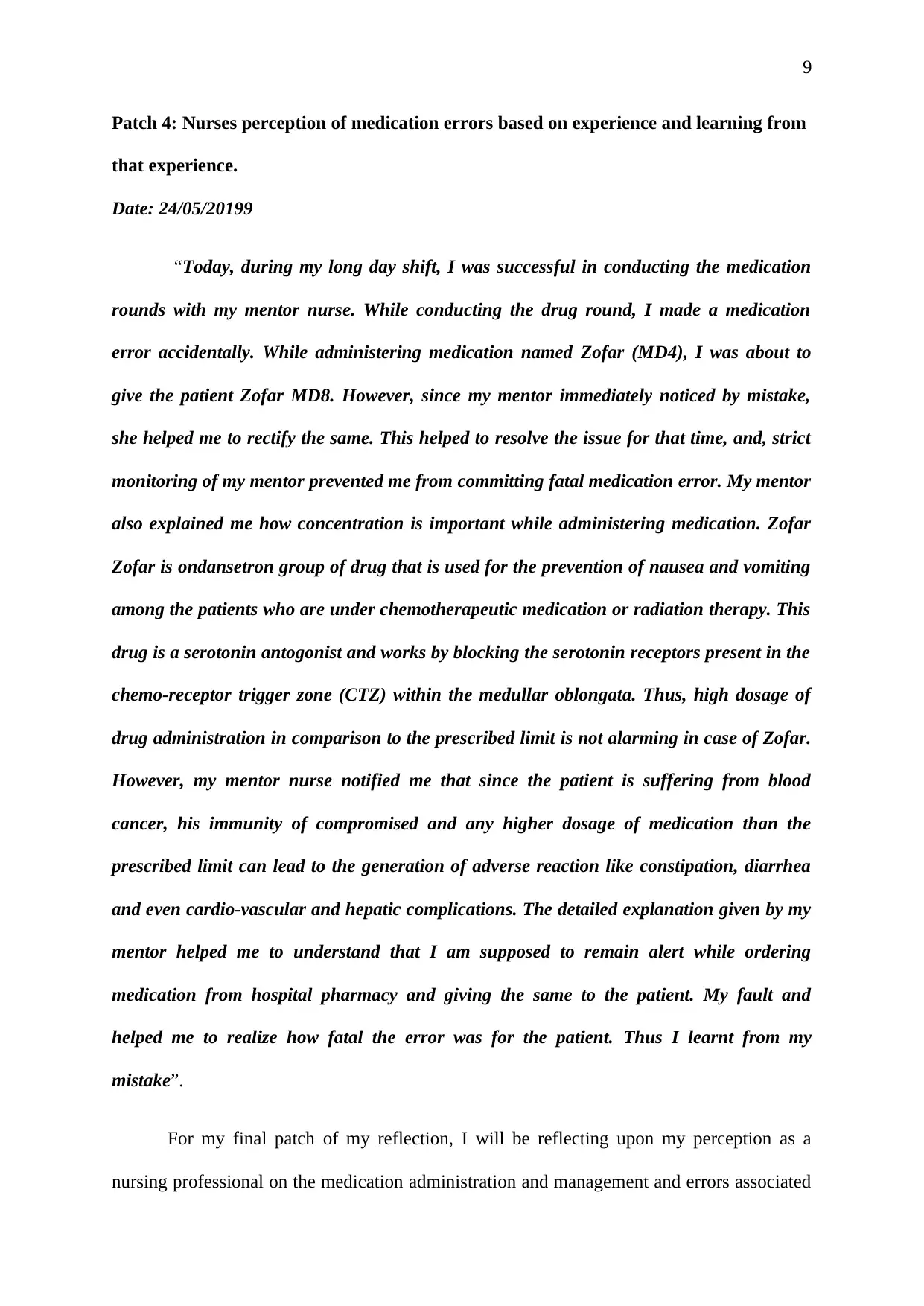
9
Patch 4: Nurses perception of medication errors based on experience and learning from
that experience.
Date: 24/05/20199
“Today, during my long day shift, I was successful in conducting the medication
rounds with my mentor nurse. While conducting the drug round, I made a medication
error accidentally. While administering medication named Zofar (MD4), I was about to
give the patient Zofar MD8. However, since my mentor immediately noticed by mistake,
she helped me to rectify the same. This helped to resolve the issue for that time, and, strict
monitoring of my mentor prevented me from committing fatal medication error. My mentor
also explained me how concentration is important while administering medication. Zofar
Zofar is ondansetron group of drug that is used for the prevention of nausea and vomiting
among the patients who are under chemotherapeutic medication or radiation therapy. This
drug is a serotonin antogonist and works by blocking the serotonin receptors present in the
chemo-receptor trigger zone (CTZ) within the medullar oblongata. Thus, high dosage of
drug administration in comparison to the prescribed limit is not alarming in case of Zofar.
However, my mentor nurse notified me that since the patient is suffering from blood
cancer, his immunity of compromised and any higher dosage of medication than the
prescribed limit can lead to the generation of adverse reaction like constipation, diarrhea
and even cardio-vascular and hepatic complications. The detailed explanation given by my
mentor helped me to understand that I am supposed to remain alert while ordering
medication from hospital pharmacy and giving the same to the patient. My fault and
helped me to realize how fatal the error was for the patient. Thus I learnt from my
mistake”.
For my final patch of my reflection, I will be reflecting upon my perception as a
nursing professional on the medication administration and management and errors associated
Patch 4: Nurses perception of medication errors based on experience and learning from
that experience.
Date: 24/05/20199
“Today, during my long day shift, I was successful in conducting the medication
rounds with my mentor nurse. While conducting the drug round, I made a medication
error accidentally. While administering medication named Zofar (MD4), I was about to
give the patient Zofar MD8. However, since my mentor immediately noticed by mistake,
she helped me to rectify the same. This helped to resolve the issue for that time, and, strict
monitoring of my mentor prevented me from committing fatal medication error. My mentor
also explained me how concentration is important while administering medication. Zofar
Zofar is ondansetron group of drug that is used for the prevention of nausea and vomiting
among the patients who are under chemotherapeutic medication or radiation therapy. This
drug is a serotonin antogonist and works by blocking the serotonin receptors present in the
chemo-receptor trigger zone (CTZ) within the medullar oblongata. Thus, high dosage of
drug administration in comparison to the prescribed limit is not alarming in case of Zofar.
However, my mentor nurse notified me that since the patient is suffering from blood
cancer, his immunity of compromised and any higher dosage of medication than the
prescribed limit can lead to the generation of adverse reaction like constipation, diarrhea
and even cardio-vascular and hepatic complications. The detailed explanation given by my
mentor helped me to understand that I am supposed to remain alert while ordering
medication from hospital pharmacy and giving the same to the patient. My fault and
helped me to realize how fatal the error was for the patient. Thus I learnt from my
mistake”.
For my final patch of my reflection, I will be reflecting upon my perception as a
nursing professional on the medication administration and management and errors associated
Secure Best Marks with AI Grader
Need help grading? Try our AI Grader for instant feedback on your assignments.
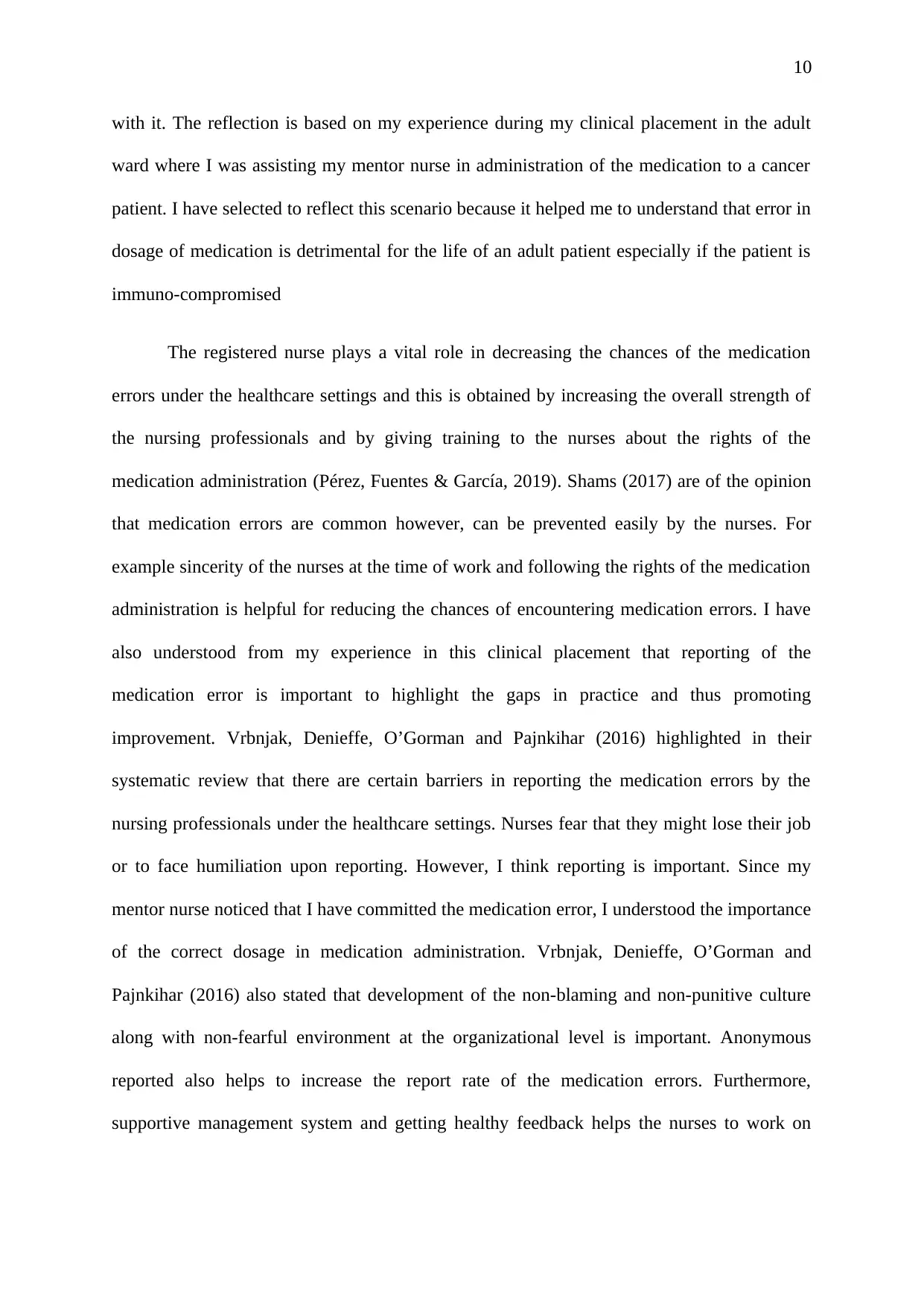
10
with it. The reflection is based on my experience during my clinical placement in the adult
ward where I was assisting my mentor nurse in administration of the medication to a cancer
patient. I have selected to reflect this scenario because it helped me to understand that error in
dosage of medication is detrimental for the life of an adult patient especially if the patient is
immuno-compromised
The registered nurse plays a vital role in decreasing the chances of the medication
errors under the healthcare settings and this is obtained by increasing the overall strength of
the nursing professionals and by giving training to the nurses about the rights of the
medication administration (Pérez, Fuentes & García, 2019). Shams (2017) are of the opinion
that medication errors are common however, can be prevented easily by the nurses. For
example sincerity of the nurses at the time of work and following the rights of the medication
administration is helpful for reducing the chances of encountering medication errors. I have
also understood from my experience in this clinical placement that reporting of the
medication error is important to highlight the gaps in practice and thus promoting
improvement. Vrbnjak, Denieffe, O’Gorman and Pajnkihar (2016) highlighted in their
systematic review that there are certain barriers in reporting the medication errors by the
nursing professionals under the healthcare settings. Nurses fear that they might lose their job
or to face humiliation upon reporting. However, I think reporting is important. Since my
mentor nurse noticed that I have committed the medication error, I understood the importance
of the correct dosage in medication administration. Vrbnjak, Denieffe, O’Gorman and
Pajnkihar (2016) also stated that development of the non-blaming and non-punitive culture
along with non-fearful environment at the organizational level is important. Anonymous
reported also helps to increase the report rate of the medication errors. Furthermore,
supportive management system and getting healthy feedback helps the nurses to work on
with it. The reflection is based on my experience during my clinical placement in the adult
ward where I was assisting my mentor nurse in administration of the medication to a cancer
patient. I have selected to reflect this scenario because it helped me to understand that error in
dosage of medication is detrimental for the life of an adult patient especially if the patient is
immuno-compromised
The registered nurse plays a vital role in decreasing the chances of the medication
errors under the healthcare settings and this is obtained by increasing the overall strength of
the nursing professionals and by giving training to the nurses about the rights of the
medication administration (Pérez, Fuentes & García, 2019). Shams (2017) are of the opinion
that medication errors are common however, can be prevented easily by the nurses. For
example sincerity of the nurses at the time of work and following the rights of the medication
administration is helpful for reducing the chances of encountering medication errors. I have
also understood from my experience in this clinical placement that reporting of the
medication error is important to highlight the gaps in practice and thus promoting
improvement. Vrbnjak, Denieffe, O’Gorman and Pajnkihar (2016) highlighted in their
systematic review that there are certain barriers in reporting the medication errors by the
nursing professionals under the healthcare settings. Nurses fear that they might lose their job
or to face humiliation upon reporting. However, I think reporting is important. Since my
mentor nurse noticed that I have committed the medication error, I understood the importance
of the correct dosage in medication administration. Vrbnjak, Denieffe, O’Gorman and
Pajnkihar (2016) also stated that development of the non-blaming and non-punitive culture
along with non-fearful environment at the organizational level is important. Anonymous
reported also helps to increase the report rate of the medication errors. Furthermore,
supportive management system and getting healthy feedback helps the nurses to work on
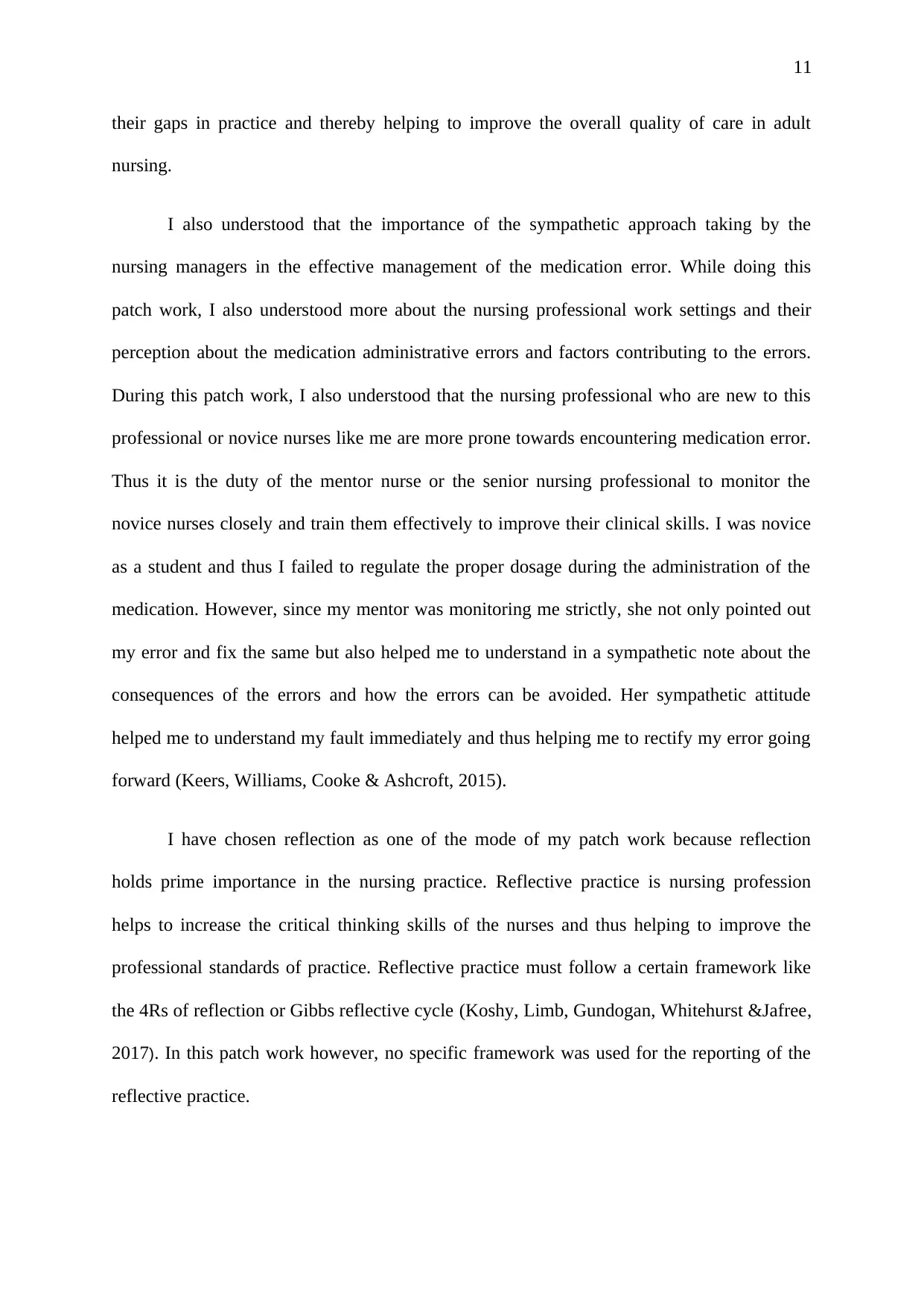
11
their gaps in practice and thereby helping to improve the overall quality of care in adult
nursing.
I also understood that the importance of the sympathetic approach taking by the
nursing managers in the effective management of the medication error. While doing this
patch work, I also understood more about the nursing professional work settings and their
perception about the medication administrative errors and factors contributing to the errors.
During this patch work, I also understood that the nursing professional who are new to this
professional or novice nurses like me are more prone towards encountering medication error.
Thus it is the duty of the mentor nurse or the senior nursing professional to monitor the
novice nurses closely and train them effectively to improve their clinical skills. I was novice
as a student and thus I failed to regulate the proper dosage during the administration of the
medication. However, since my mentor was monitoring me strictly, she not only pointed out
my error and fix the same but also helped me to understand in a sympathetic note about the
consequences of the errors and how the errors can be avoided. Her sympathetic attitude
helped me to understand my fault immediately and thus helping me to rectify my error going
forward (Keers, Williams, Cooke & Ashcroft, 2015).
I have chosen reflection as one of the mode of my patch work because reflection
holds prime importance in the nursing practice. Reflective practice is nursing profession
helps to increase the critical thinking skills of the nurses and thus helping to improve the
professional standards of practice. Reflective practice must follow a certain framework like
the 4Rs of reflection or Gibbs reflective cycle (Koshy, Limb, Gundogan, Whitehurst &Jafree,
2017). In this patch work however, no specific framework was used for the reporting of the
reflective practice.
their gaps in practice and thereby helping to improve the overall quality of care in adult
nursing.
I also understood that the importance of the sympathetic approach taking by the
nursing managers in the effective management of the medication error. While doing this
patch work, I also understood more about the nursing professional work settings and their
perception about the medication administrative errors and factors contributing to the errors.
During this patch work, I also understood that the nursing professional who are new to this
professional or novice nurses like me are more prone towards encountering medication error.
Thus it is the duty of the mentor nurse or the senior nursing professional to monitor the
novice nurses closely and train them effectively to improve their clinical skills. I was novice
as a student and thus I failed to regulate the proper dosage during the administration of the
medication. However, since my mentor was monitoring me strictly, she not only pointed out
my error and fix the same but also helped me to understand in a sympathetic note about the
consequences of the errors and how the errors can be avoided. Her sympathetic attitude
helped me to understand my fault immediately and thus helping me to rectify my error going
forward (Keers, Williams, Cooke & Ashcroft, 2015).
I have chosen reflection as one of the mode of my patch work because reflection
holds prime importance in the nursing practice. Reflective practice is nursing profession
helps to increase the critical thinking skills of the nurses and thus helping to improve the
professional standards of practice. Reflective practice must follow a certain framework like
the 4Rs of reflection or Gibbs reflective cycle (Koshy, Limb, Gundogan, Whitehurst &Jafree,
2017). In this patch work however, no specific framework was used for the reporting of the
reflective practice.
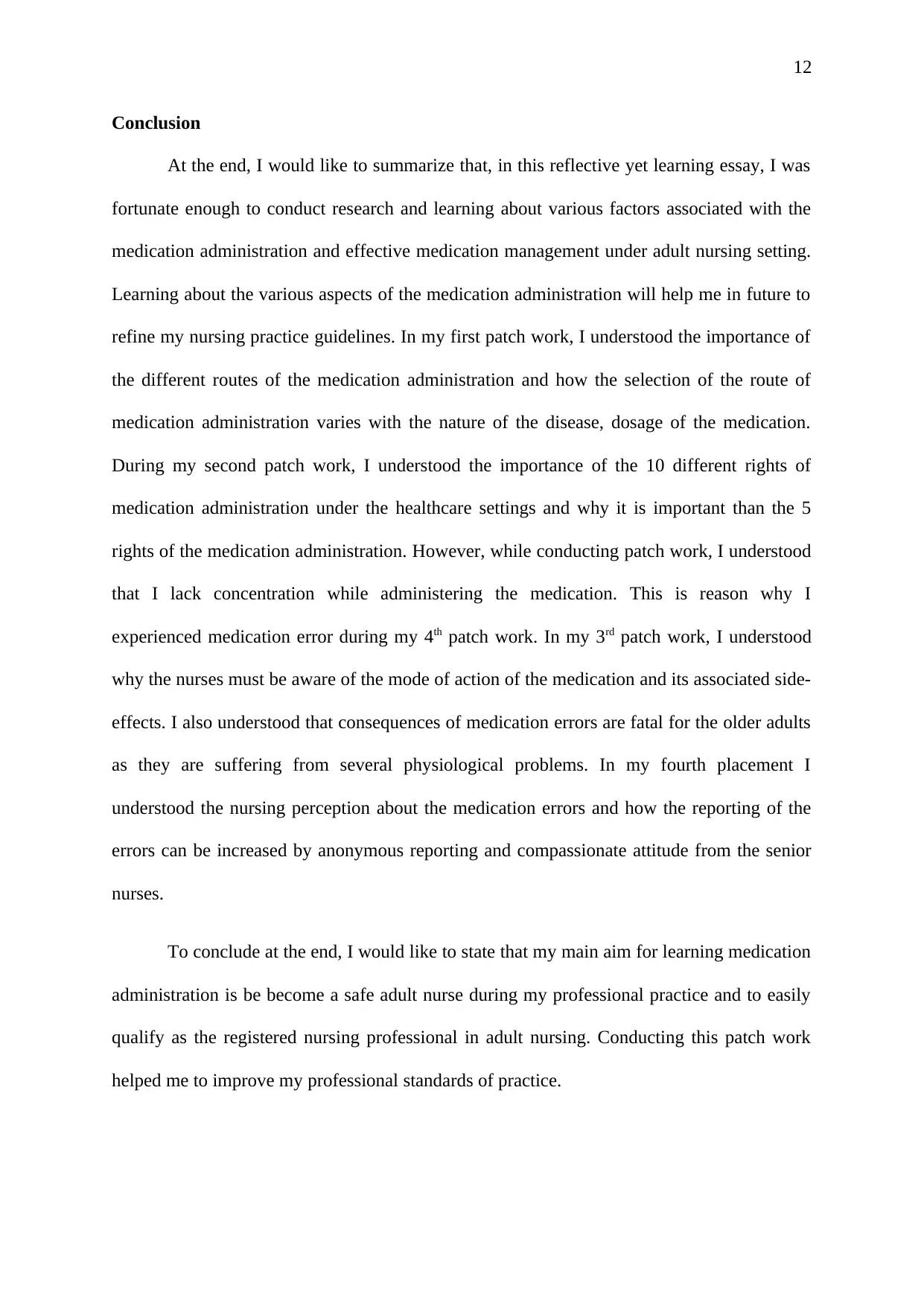
12
Conclusion
At the end, I would like to summarize that, in this reflective yet learning essay, I was
fortunate enough to conduct research and learning about various factors associated with the
medication administration and effective medication management under adult nursing setting.
Learning about the various aspects of the medication administration will help me in future to
refine my nursing practice guidelines. In my first patch work, I understood the importance of
the different routes of the medication administration and how the selection of the route of
medication administration varies with the nature of the disease, dosage of the medication.
During my second patch work, I understood the importance of the 10 different rights of
medication administration under the healthcare settings and why it is important than the 5
rights of the medication administration. However, while conducting patch work, I understood
that I lack concentration while administering the medication. This is reason why I
experienced medication error during my 4th patch work. In my 3rd patch work, I understood
why the nurses must be aware of the mode of action of the medication and its associated side-
effects. I also understood that consequences of medication errors are fatal for the older adults
as they are suffering from several physiological problems. In my fourth placement I
understood the nursing perception about the medication errors and how the reporting of the
errors can be increased by anonymous reporting and compassionate attitude from the senior
nurses.
To conclude at the end, I would like to state that my main aim for learning medication
administration is be become a safe adult nurse during my professional practice and to easily
qualify as the registered nursing professional in adult nursing. Conducting this patch work
helped me to improve my professional standards of practice.
Conclusion
At the end, I would like to summarize that, in this reflective yet learning essay, I was
fortunate enough to conduct research and learning about various factors associated with the
medication administration and effective medication management under adult nursing setting.
Learning about the various aspects of the medication administration will help me in future to
refine my nursing practice guidelines. In my first patch work, I understood the importance of
the different routes of the medication administration and how the selection of the route of
medication administration varies with the nature of the disease, dosage of the medication.
During my second patch work, I understood the importance of the 10 different rights of
medication administration under the healthcare settings and why it is important than the 5
rights of the medication administration. However, while conducting patch work, I understood
that I lack concentration while administering the medication. This is reason why I
experienced medication error during my 4th patch work. In my 3rd patch work, I understood
why the nurses must be aware of the mode of action of the medication and its associated side-
effects. I also understood that consequences of medication errors are fatal for the older adults
as they are suffering from several physiological problems. In my fourth placement I
understood the nursing perception about the medication errors and how the reporting of the
errors can be increased by anonymous reporting and compassionate attitude from the senior
nurses.
To conclude at the end, I would like to state that my main aim for learning medication
administration is be become a safe adult nurse during my professional practice and to easily
qualify as the registered nursing professional in adult nursing. Conducting this patch work
helped me to improve my professional standards of practice.
Paraphrase This Document
Need a fresh take? Get an instant paraphrase of this document with our AI Paraphraser
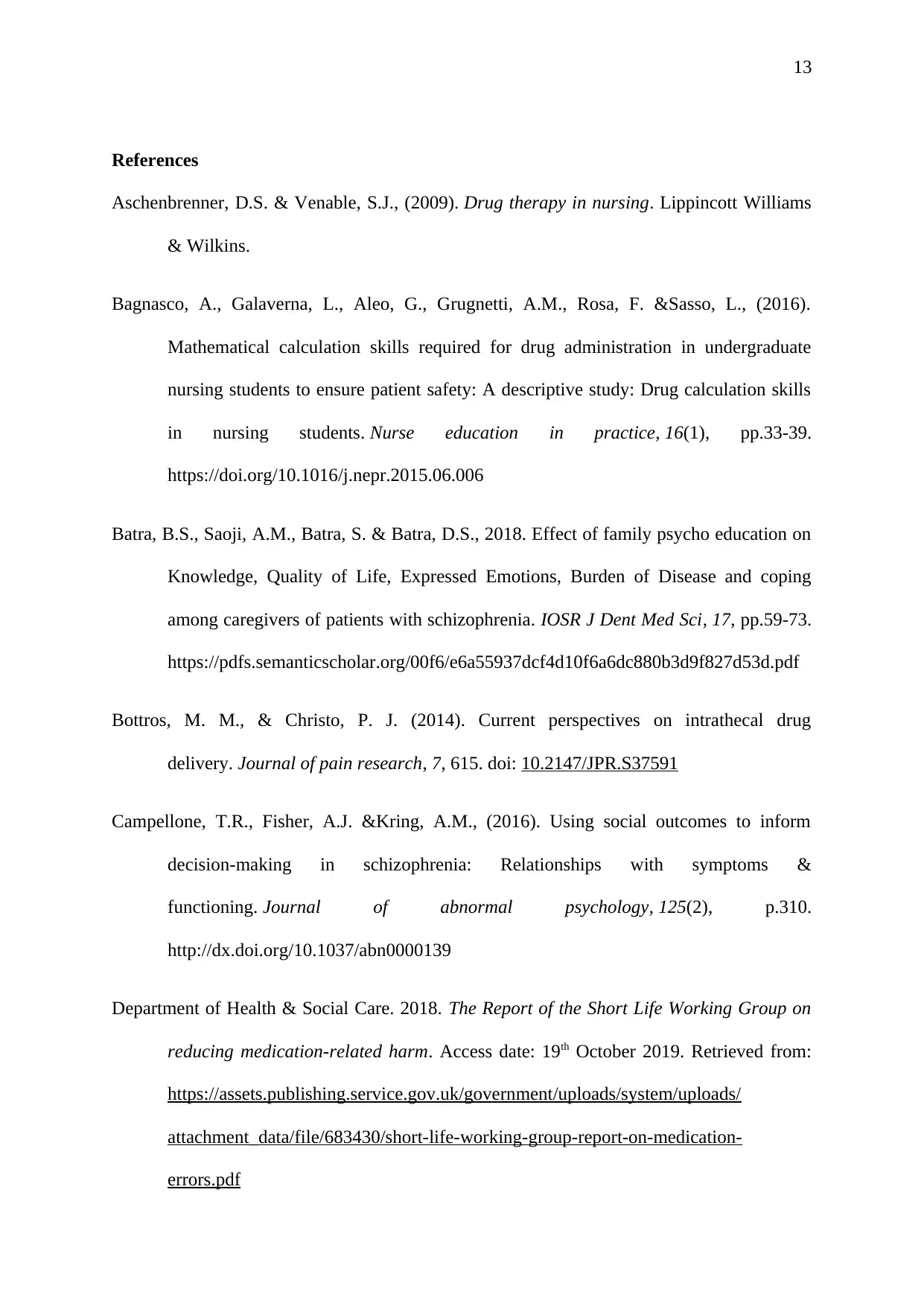
13
References
Aschenbrenner, D.S. & Venable, S.J., (2009). Drug therapy in nursing. Lippincott Williams
& Wilkins.
Bagnasco, A., Galaverna, L., Aleo, G., Grugnetti, A.M., Rosa, F. &Sasso, L., (2016).
Mathematical calculation skills required for drug administration in undergraduate
nursing students to ensure patient safety: A descriptive study: Drug calculation skills
in nursing students. Nurse education in practice, 16(1), pp.33-39.
https://doi.org/10.1016/j.nepr.2015.06.006
Batra, B.S., Saoji, A.M., Batra, S. & Batra, D.S., 2018. Effect of family psycho education on
Knowledge, Quality of Life, Expressed Emotions, Burden of Disease and coping
among caregivers of patients with schizophrenia. IOSR J Dent Med Sci, 17, pp.59-73.
https://pdfs.semanticscholar.org/00f6/e6a55937dcf4d10f6a6dc880b3d9f827d53d.pdf
Bottros, M. M., & Christo, P. J. (2014). Current perspectives on intrathecal drug
delivery. Journal of pain research, 7, 615. doi: 10.2147/JPR.S37591
Campellone, T.R., Fisher, A.J. &Kring, A.M., (2016). Using social outcomes to inform
decision-making in schizophrenia: Relationships with symptoms &
functioning. Journal of abnormal psychology, 125(2), p.310.
http://dx.doi.org/10.1037/abn0000139
Department of Health & Social Care. 2018. The Report of the Short Life Working Group on
reducing medication-related harm. Access date: 19th October 2019. Retrieved from:
https://assets.publishing.service.gov.uk/government/uploads/system/uploads/
attachment_data/file/683430/short-life-working-group-report-on-medication-
errors.pdf
References
Aschenbrenner, D.S. & Venable, S.J., (2009). Drug therapy in nursing. Lippincott Williams
& Wilkins.
Bagnasco, A., Galaverna, L., Aleo, G., Grugnetti, A.M., Rosa, F. &Sasso, L., (2016).
Mathematical calculation skills required for drug administration in undergraduate
nursing students to ensure patient safety: A descriptive study: Drug calculation skills
in nursing students. Nurse education in practice, 16(1), pp.33-39.
https://doi.org/10.1016/j.nepr.2015.06.006
Batra, B.S., Saoji, A.M., Batra, S. & Batra, D.S., 2018. Effect of family psycho education on
Knowledge, Quality of Life, Expressed Emotions, Burden of Disease and coping
among caregivers of patients with schizophrenia. IOSR J Dent Med Sci, 17, pp.59-73.
https://pdfs.semanticscholar.org/00f6/e6a55937dcf4d10f6a6dc880b3d9f827d53d.pdf
Bottros, M. M., & Christo, P. J. (2014). Current perspectives on intrathecal drug
delivery. Journal of pain research, 7, 615. doi: 10.2147/JPR.S37591
Campellone, T.R., Fisher, A.J. &Kring, A.M., (2016). Using social outcomes to inform
decision-making in schizophrenia: Relationships with symptoms &
functioning. Journal of abnormal psychology, 125(2), p.310.
http://dx.doi.org/10.1037/abn0000139
Department of Health & Social Care. 2018. The Report of the Short Life Working Group on
reducing medication-related harm. Access date: 19th October 2019. Retrieved from:
https://assets.publishing.service.gov.uk/government/uploads/system/uploads/
attachment_data/file/683430/short-life-working-group-report-on-medication-
errors.pdf
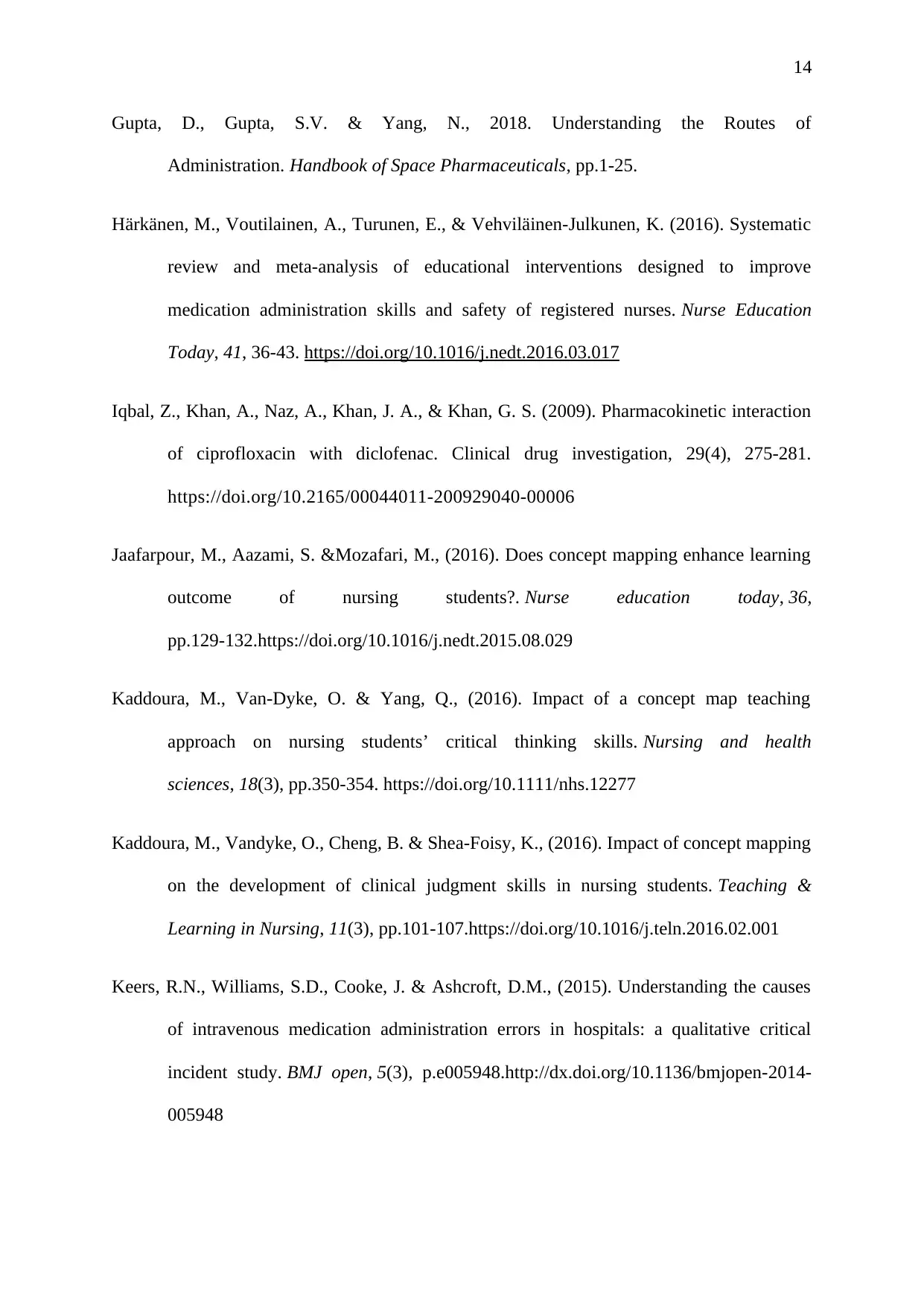
14
Gupta, D., Gupta, S.V. & Yang, N., 2018. Understanding the Routes of
Administration. Handbook of Space Pharmaceuticals, pp.1-25.
Härkänen, M., Voutilainen, A., Turunen, E., & Vehviläinen-Julkunen, K. (2016). Systematic
review and meta-analysis of educational interventions designed to improve
medication administration skills and safety of registered nurses. Nurse Education
Today, 41, 36-43. https://doi.org/10.1016/j.nedt.2016.03.017
Iqbal, Z., Khan, A., Naz, A., Khan, J. A., & Khan, G. S. (2009). Pharmacokinetic interaction
of ciprofloxacin with diclofenac. Clinical drug investigation, 29(4), 275-281.
https://doi.org/10.2165/00044011-200929040-00006
Jaafarpour, M., Aazami, S. &Mozafari, M., (2016). Does concept mapping enhance learning
outcome of nursing students?. Nurse education today, 36,
pp.129-132.https://doi.org/10.1016/j.nedt.2015.08.029
Kaddoura, M., Van‐Dyke, O. & Yang, Q., (2016). Impact of a concept map teaching
approach on nursing students’ critical thinking skills. Nursing and health
sciences, 18(3), pp.350-354. https://doi.org/10.1111/nhs.12277
Kaddoura, M., Vandyke, O., Cheng, B. & Shea-Foisy, K., (2016). Impact of concept mapping
on the development of clinical judgment skills in nursing students. Teaching &
Learning in Nursing, 11(3), pp.101-107.https://doi.org/10.1016/j.teln.2016.02.001
Keers, R.N., Williams, S.D., Cooke, J. & Ashcroft, D.M., (2015). Understanding the causes
of intravenous medication administration errors in hospitals: a qualitative critical
incident study. BMJ open, 5(3), p.e005948.http://dx.doi.org/10.1136/bmjopen-2014-
005948
Gupta, D., Gupta, S.V. & Yang, N., 2018. Understanding the Routes of
Administration. Handbook of Space Pharmaceuticals, pp.1-25.
Härkänen, M., Voutilainen, A., Turunen, E., & Vehviläinen-Julkunen, K. (2016). Systematic
review and meta-analysis of educational interventions designed to improve
medication administration skills and safety of registered nurses. Nurse Education
Today, 41, 36-43. https://doi.org/10.1016/j.nedt.2016.03.017
Iqbal, Z., Khan, A., Naz, A., Khan, J. A., & Khan, G. S. (2009). Pharmacokinetic interaction
of ciprofloxacin with diclofenac. Clinical drug investigation, 29(4), 275-281.
https://doi.org/10.2165/00044011-200929040-00006
Jaafarpour, M., Aazami, S. &Mozafari, M., (2016). Does concept mapping enhance learning
outcome of nursing students?. Nurse education today, 36,
pp.129-132.https://doi.org/10.1016/j.nedt.2015.08.029
Kaddoura, M., Van‐Dyke, O. & Yang, Q., (2016). Impact of a concept map teaching
approach on nursing students’ critical thinking skills. Nursing and health
sciences, 18(3), pp.350-354. https://doi.org/10.1111/nhs.12277
Kaddoura, M., Vandyke, O., Cheng, B. & Shea-Foisy, K., (2016). Impact of concept mapping
on the development of clinical judgment skills in nursing students. Teaching &
Learning in Nursing, 11(3), pp.101-107.https://doi.org/10.1016/j.teln.2016.02.001
Keers, R.N., Williams, S.D., Cooke, J. & Ashcroft, D.M., (2015). Understanding the causes
of intravenous medication administration errors in hospitals: a qualitative critical
incident study. BMJ open, 5(3), p.e005948.http://dx.doi.org/10.1136/bmjopen-2014-
005948
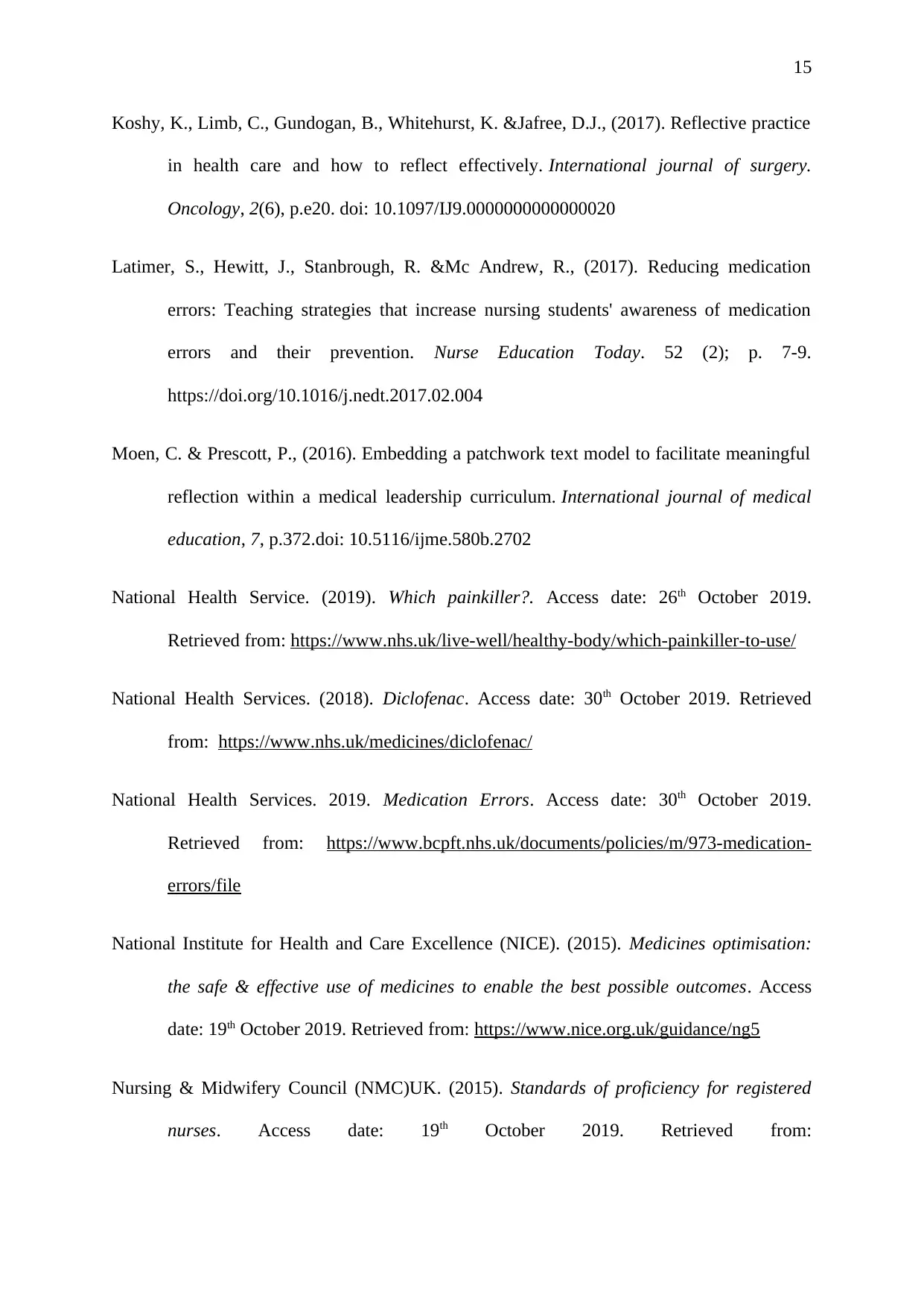
15
Koshy, K., Limb, C., Gundogan, B., Whitehurst, K. &Jafree, D.J., (2017). Reflective practice
in health care and how to reflect effectively. International journal of surgery.
Oncology, 2(6), p.e20. doi: 10.1097/IJ9.0000000000000020
Latimer, S., Hewitt, J., Stanbrough, R. &Mc Andrew, R., (2017). Reducing medication
errors: Teaching strategies that increase nursing students' awareness of medication
errors and their prevention. Nurse Education Today. 52 (2); p. 7-9.
https://doi.org/10.1016/j.nedt.2017.02.004
Moen, C. & Prescott, P., (2016). Embedding a patchwork text model to facilitate meaningful
reflection within a medical leadership curriculum. International journal of medical
education, 7, p.372.doi: 10.5116/ijme.580b.2702
National Health Service. (2019). Which painkiller?. Access date: 26th October 2019.
Retrieved from: https://www.nhs.uk/live-well/healthy-body/which-painkiller-to-use/
National Health Services. (2018). Diclofenac. Access date: 30th October 2019. Retrieved
from: https://www.nhs.uk/medicines/diclofenac/
National Health Services. 2019. Medication Errors. Access date: 30th October 2019.
Retrieved from: https://www.bcpft.nhs.uk/documents/policies/m/973-medication-
errors/file
National Institute for Health and Care Excellence (NICE). (2015). Medicines optimisation:
the safe & effective use of medicines to enable the best possible outcomes. Access
date: 19th October 2019. Retrieved from: https://www.nice.org.uk/guidance/ng5
Nursing & Midwifery Council (NMC)UK. (2015). Standards of proficiency for registered
nurses. Access date: 19th October 2019. Retrieved from:
Koshy, K., Limb, C., Gundogan, B., Whitehurst, K. &Jafree, D.J., (2017). Reflective practice
in health care and how to reflect effectively. International journal of surgery.
Oncology, 2(6), p.e20. doi: 10.1097/IJ9.0000000000000020
Latimer, S., Hewitt, J., Stanbrough, R. &Mc Andrew, R., (2017). Reducing medication
errors: Teaching strategies that increase nursing students' awareness of medication
errors and their prevention. Nurse Education Today. 52 (2); p. 7-9.
https://doi.org/10.1016/j.nedt.2017.02.004
Moen, C. & Prescott, P., (2016). Embedding a patchwork text model to facilitate meaningful
reflection within a medical leadership curriculum. International journal of medical
education, 7, p.372.doi: 10.5116/ijme.580b.2702
National Health Service. (2019). Which painkiller?. Access date: 26th October 2019.
Retrieved from: https://www.nhs.uk/live-well/healthy-body/which-painkiller-to-use/
National Health Services. (2018). Diclofenac. Access date: 30th October 2019. Retrieved
from: https://www.nhs.uk/medicines/diclofenac/
National Health Services. 2019. Medication Errors. Access date: 30th October 2019.
Retrieved from: https://www.bcpft.nhs.uk/documents/policies/m/973-medication-
errors/file
National Institute for Health and Care Excellence (NICE). (2015). Medicines optimisation:
the safe & effective use of medicines to enable the best possible outcomes. Access
date: 19th October 2019. Retrieved from: https://www.nice.org.uk/guidance/ng5
Nursing & Midwifery Council (NMC)UK. (2015). Standards of proficiency for registered
nurses. Access date: 19th October 2019. Retrieved from:
Secure Best Marks with AI Grader
Need help grading? Try our AI Grader for instant feedback on your assignments.
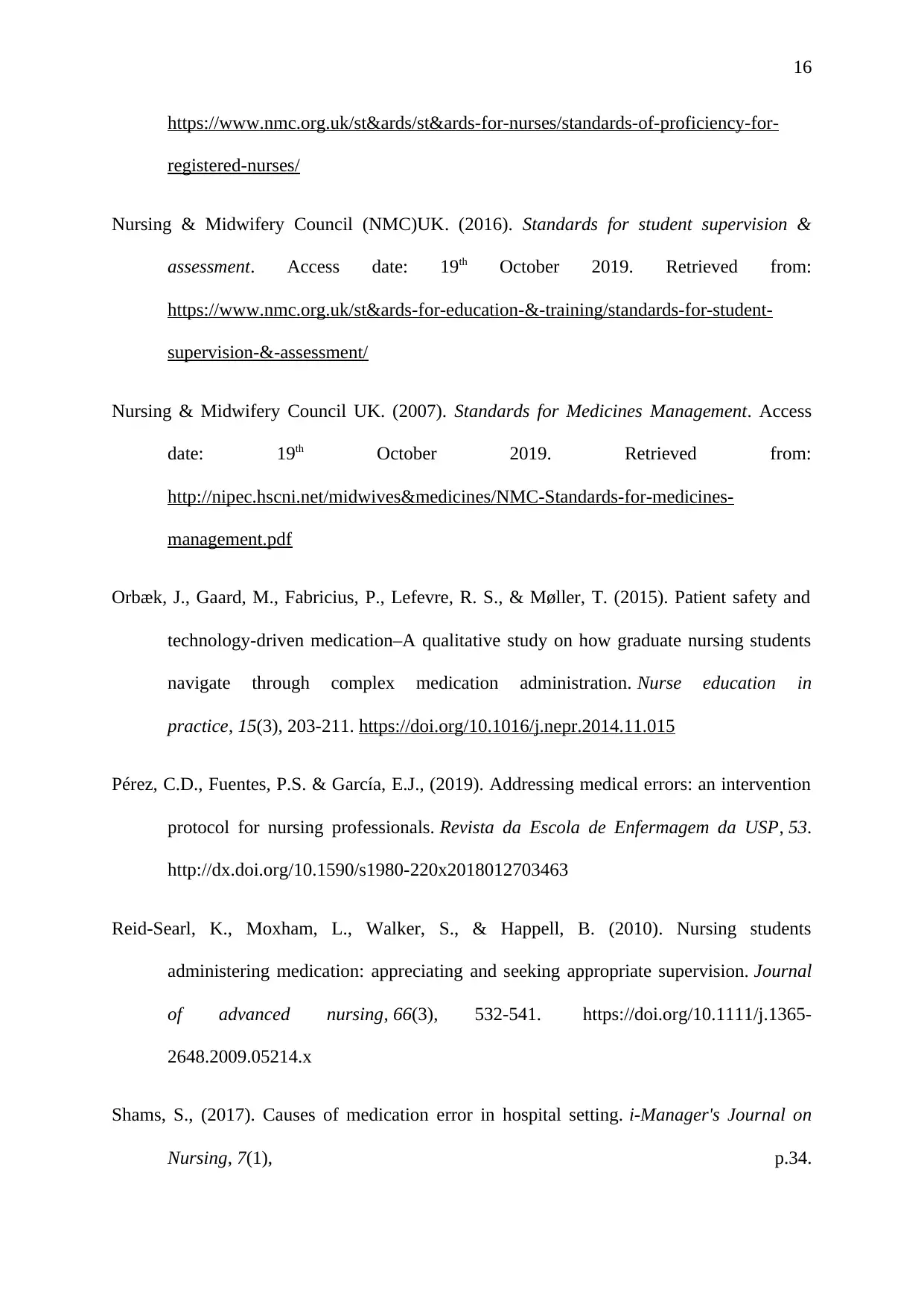
16
https://www.nmc.org.uk/st&ards/st&ards-for-nurses/standards-of-proficiency-for-
registered-nurses/
Nursing & Midwifery Council (NMC)UK. (2016). Standards for student supervision &
assessment. Access date: 19th October 2019. Retrieved from:
https://www.nmc.org.uk/st&ards-for-education-&-training/standards-for-student-
supervision-&-assessment/
Nursing & Midwifery Council UK. (2007). Standards for Medicines Management. Access
date: 19th October 2019. Retrieved from:
http://nipec.hscni.net/midwives&medicines/NMC-Standards-for-medicines-
management.pdf
Orbæk, J., Gaard, M., Fabricius, P., Lefevre, R. S., & Møller, T. (2015). Patient safety and
technology-driven medication–A qualitative study on how graduate nursing students
navigate through complex medication administration. Nurse education in
practice, 15(3), 203-211. https://doi.org/10.1016/j.nepr.2014.11.015
Pérez, C.D., Fuentes, P.S. & García, E.J., (2019). Addressing medical errors: an intervention
protocol for nursing professionals. Revista da Escola de Enfermagem da USP, 53.
http://dx.doi.org/10.1590/s1980-220x2018012703463
Reid‐Searl, K., Moxham, L., Walker, S., & Happell, B. (2010). Nursing students
administering medication: appreciating and seeking appropriate supervision. Journal
of advanced nursing, 66(3), 532-541. https://doi.org/10.1111/j.1365-
2648.2009.05214.x
Shams, S., (2017). Causes of medication error in hospital setting. i-Manager's Journal on
Nursing, 7(1), p.34.
https://www.nmc.org.uk/st&ards/st&ards-for-nurses/standards-of-proficiency-for-
registered-nurses/
Nursing & Midwifery Council (NMC)UK. (2016). Standards for student supervision &
assessment. Access date: 19th October 2019. Retrieved from:
https://www.nmc.org.uk/st&ards-for-education-&-training/standards-for-student-
supervision-&-assessment/
Nursing & Midwifery Council UK. (2007). Standards for Medicines Management. Access
date: 19th October 2019. Retrieved from:
http://nipec.hscni.net/midwives&medicines/NMC-Standards-for-medicines-
management.pdf
Orbæk, J., Gaard, M., Fabricius, P., Lefevre, R. S., & Møller, T. (2015). Patient safety and
technology-driven medication–A qualitative study on how graduate nursing students
navigate through complex medication administration. Nurse education in
practice, 15(3), 203-211. https://doi.org/10.1016/j.nepr.2014.11.015
Pérez, C.D., Fuentes, P.S. & García, E.J., (2019). Addressing medical errors: an intervention
protocol for nursing professionals. Revista da Escola de Enfermagem da USP, 53.
http://dx.doi.org/10.1590/s1980-220x2018012703463
Reid‐Searl, K., Moxham, L., Walker, S., & Happell, B. (2010). Nursing students
administering medication: appreciating and seeking appropriate supervision. Journal
of advanced nursing, 66(3), 532-541. https://doi.org/10.1111/j.1365-
2648.2009.05214.x
Shams, S., (2017). Causes of medication error in hospital setting. i-Manager's Journal on
Nursing, 7(1), p.34.
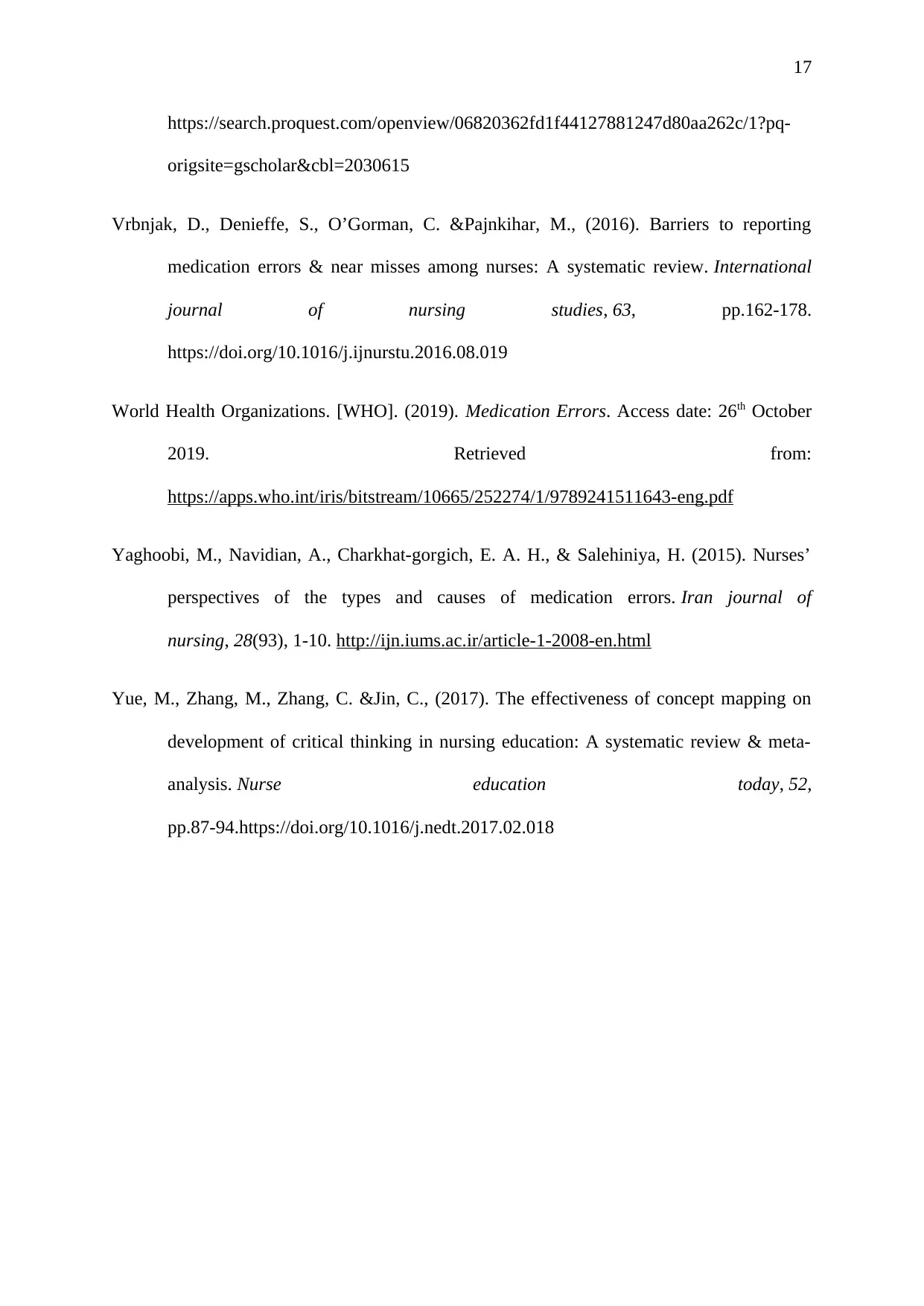
17
https://search.proquest.com/openview/06820362fd1f44127881247d80aa262c/1?pq-
origsite=gscholar&cbl=2030615
Vrbnjak, D., Denieffe, S., O’Gorman, C. &Pajnkihar, M., (2016). Barriers to reporting
medication errors & near misses among nurses: A systematic review. International
journal of nursing studies, 63, pp.162-178.
https://doi.org/10.1016/j.ijnurstu.2016.08.019
World Health Organizations. [WHO]. (2019). Medication Errors. Access date: 26th October
2019. Retrieved from:
https://apps.who.int/iris/bitstream/10665/252274/1/9789241511643-eng.pdf
Yaghoobi, M., Navidian, A., Charkhat-gorgich, E. A. H., & Salehiniya, H. (2015). Nurses’
perspectives of the types and causes of medication errors. Iran journal of
nursing, 28(93), 1-10. http://ijn.iums.ac.ir/article-1-2008-en.html
Yue, M., Zhang, M., Zhang, C. &Jin, C., (2017). The effectiveness of concept mapping on
development of critical thinking in nursing education: A systematic review & meta-
analysis. Nurse education today, 52,
pp.87-94.https://doi.org/10.1016/j.nedt.2017.02.018
https://search.proquest.com/openview/06820362fd1f44127881247d80aa262c/1?pq-
origsite=gscholar&cbl=2030615
Vrbnjak, D., Denieffe, S., O’Gorman, C. &Pajnkihar, M., (2016). Barriers to reporting
medication errors & near misses among nurses: A systematic review. International
journal of nursing studies, 63, pp.162-178.
https://doi.org/10.1016/j.ijnurstu.2016.08.019
World Health Organizations. [WHO]. (2019). Medication Errors. Access date: 26th October
2019. Retrieved from:
https://apps.who.int/iris/bitstream/10665/252274/1/9789241511643-eng.pdf
Yaghoobi, M., Navidian, A., Charkhat-gorgich, E. A. H., & Salehiniya, H. (2015). Nurses’
perspectives of the types and causes of medication errors. Iran journal of
nursing, 28(93), 1-10. http://ijn.iums.ac.ir/article-1-2008-en.html
Yue, M., Zhang, M., Zhang, C. &Jin, C., (2017). The effectiveness of concept mapping on
development of critical thinking in nursing education: A systematic review & meta-
analysis. Nurse education today, 52,
pp.87-94.https://doi.org/10.1016/j.nedt.2017.02.018
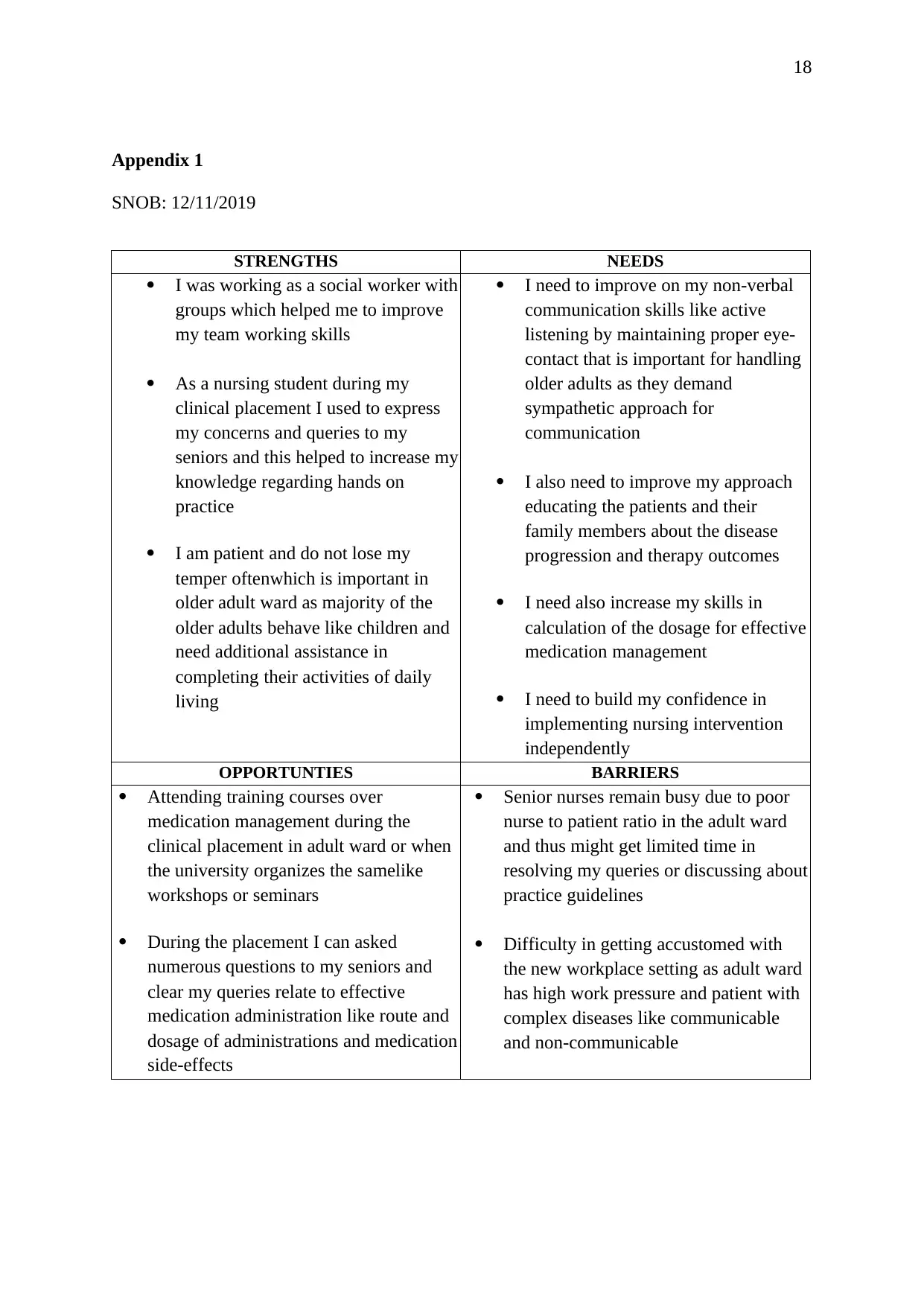
18
Appendix 1
SNOB: 12/11/2019
STRENGTHS NEEDS
I was working as a social worker with
groups which helped me to improve
my team working skills
As a nursing student during my
clinical placement I used to express
my concerns and queries to my
seniors and this helped to increase my
knowledge regarding hands on
practice
I am patient and do not lose my
temper oftenwhich is important in
older adult ward as majority of the
older adults behave like children and
need additional assistance in
completing their activities of daily
living
I need to improve on my non-verbal
communication skills like active
listening by maintaining proper eye-
contact that is important for handling
older adults as they demand
sympathetic approach for
communication
I also need to improve my approach
educating the patients and their
family members about the disease
progression and therapy outcomes
I need also increase my skills in
calculation of the dosage for effective
medication management
I need to build my confidence in
implementing nursing intervention
independently
OPPORTUNTIES BARRIERS
Attending training courses over
medication management during the
clinical placement in adult ward or when
the university organizes the samelike
workshops or seminars
During the placement I can asked
numerous questions to my seniors and
clear my queries relate to effective
medication administration like route and
dosage of administrations and medication
side-effects
Senior nurses remain busy due to poor
nurse to patient ratio in the adult ward
and thus might get limited time in
resolving my queries or discussing about
practice guidelines
Difficulty in getting accustomed with
the new workplace setting as adult ward
has high work pressure and patient with
complex diseases like communicable
and non-communicable
Appendix 1
SNOB: 12/11/2019
STRENGTHS NEEDS
I was working as a social worker with
groups which helped me to improve
my team working skills
As a nursing student during my
clinical placement I used to express
my concerns and queries to my
seniors and this helped to increase my
knowledge regarding hands on
practice
I am patient and do not lose my
temper oftenwhich is important in
older adult ward as majority of the
older adults behave like children and
need additional assistance in
completing their activities of daily
living
I need to improve on my non-verbal
communication skills like active
listening by maintaining proper eye-
contact that is important for handling
older adults as they demand
sympathetic approach for
communication
I also need to improve my approach
educating the patients and their
family members about the disease
progression and therapy outcomes
I need also increase my skills in
calculation of the dosage for effective
medication management
I need to build my confidence in
implementing nursing intervention
independently
OPPORTUNTIES BARRIERS
Attending training courses over
medication management during the
clinical placement in adult ward or when
the university organizes the samelike
workshops or seminars
During the placement I can asked
numerous questions to my seniors and
clear my queries relate to effective
medication administration like route and
dosage of administrations and medication
side-effects
Senior nurses remain busy due to poor
nurse to patient ratio in the adult ward
and thus might get limited time in
resolving my queries or discussing about
practice guidelines
Difficulty in getting accustomed with
the new workplace setting as adult ward
has high work pressure and patient with
complex diseases like communicable
and non-communicable
Paraphrase This Document
Need a fresh take? Get an instant paraphrase of this document with our AI Paraphraser
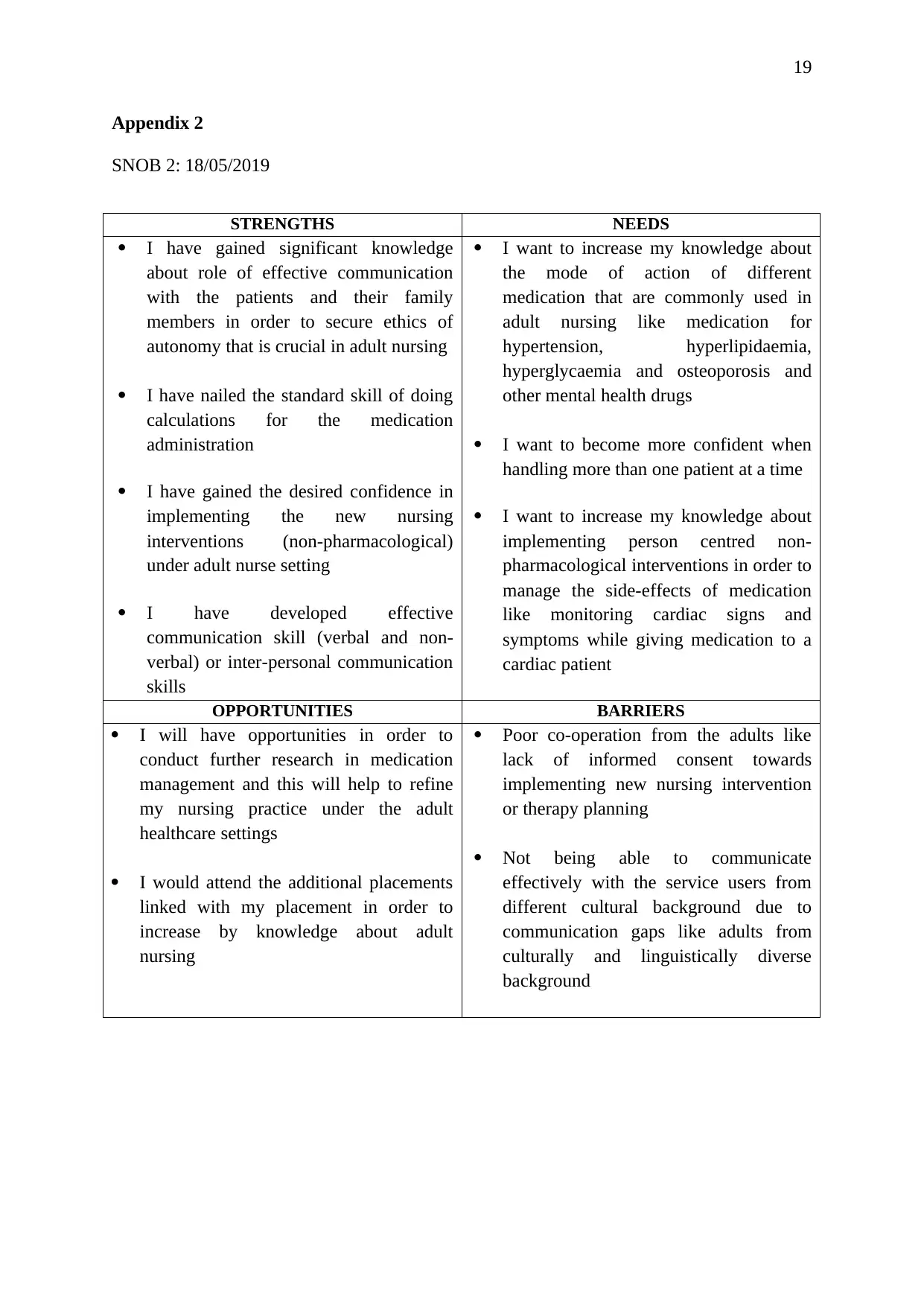
19
Appendix 2
SNOB 2: 18/05/2019
STRENGTHS NEEDS
I have gained significant knowledge
about role of effective communication
with the patients and their family
members in order to secure ethics of
autonomy that is crucial in adult nursing
I have nailed the standard skill of doing
calculations for the medication
administration
I have gained the desired confidence in
implementing the new nursing
interventions (non-pharmacological)
under adult nurse setting
I have developed effective
communication skill (verbal and non-
verbal) or inter-personal communication
skills
I want to increase my knowledge about
the mode of action of different
medication that are commonly used in
adult nursing like medication for
hypertension, hyperlipidaemia,
hyperglycaemia and osteoporosis and
other mental health drugs
I want to become more confident when
handling more than one patient at a time
I want to increase my knowledge about
implementing person centred non-
pharmacological interventions in order to
manage the side-effects of medication
like monitoring cardiac signs and
symptoms while giving medication to a
cardiac patient
OPPORTUNITIES BARRIERS
I will have opportunities in order to
conduct further research in medication
management and this will help to refine
my nursing practice under the adult
healthcare settings
I would attend the additional placements
linked with my placement in order to
increase by knowledge about adult
nursing
Poor co-operation from the adults like
lack of informed consent towards
implementing new nursing intervention
or therapy planning
Not being able to communicate
effectively with the service users from
different cultural background due to
communication gaps like adults from
culturally and linguistically diverse
background
Appendix 2
SNOB 2: 18/05/2019
STRENGTHS NEEDS
I have gained significant knowledge
about role of effective communication
with the patients and their family
members in order to secure ethics of
autonomy that is crucial in adult nursing
I have nailed the standard skill of doing
calculations for the medication
administration
I have gained the desired confidence in
implementing the new nursing
interventions (non-pharmacological)
under adult nurse setting
I have developed effective
communication skill (verbal and non-
verbal) or inter-personal communication
skills
I want to increase my knowledge about
the mode of action of different
medication that are commonly used in
adult nursing like medication for
hypertension, hyperlipidaemia,
hyperglycaemia and osteoporosis and
other mental health drugs
I want to become more confident when
handling more than one patient at a time
I want to increase my knowledge about
implementing person centred non-
pharmacological interventions in order to
manage the side-effects of medication
like monitoring cardiac signs and
symptoms while giving medication to a
cardiac patient
OPPORTUNITIES BARRIERS
I will have opportunities in order to
conduct further research in medication
management and this will help to refine
my nursing practice under the adult
healthcare settings
I would attend the additional placements
linked with my placement in order to
increase by knowledge about adult
nursing
Poor co-operation from the adults like
lack of informed consent towards
implementing new nursing intervention
or therapy planning
Not being able to communicate
effectively with the service users from
different cultural background due to
communication gaps like adults from
culturally and linguistically diverse
background
1 out of 20
Related Documents
Your All-in-One AI-Powered Toolkit for Academic Success.
+13062052269
info@desklib.com
Available 24*7 on WhatsApp / Email
![[object Object]](/_next/static/media/star-bottom.7253800d.svg)
Unlock your academic potential
© 2024 | Zucol Services PVT LTD | All rights reserved.





